Well that’s summer over then, the nights are drawing in and it’s time to start looking for your winter build projects… just kidding! We had some lovely weather in June, including two heatwaves when for we all moaned that it was too hot. The sunshine brought out lots of club members and we enjoyed plenty of flying. There were several days with strong winds, but with very little rain the grass barely grew and mowing was rarely required.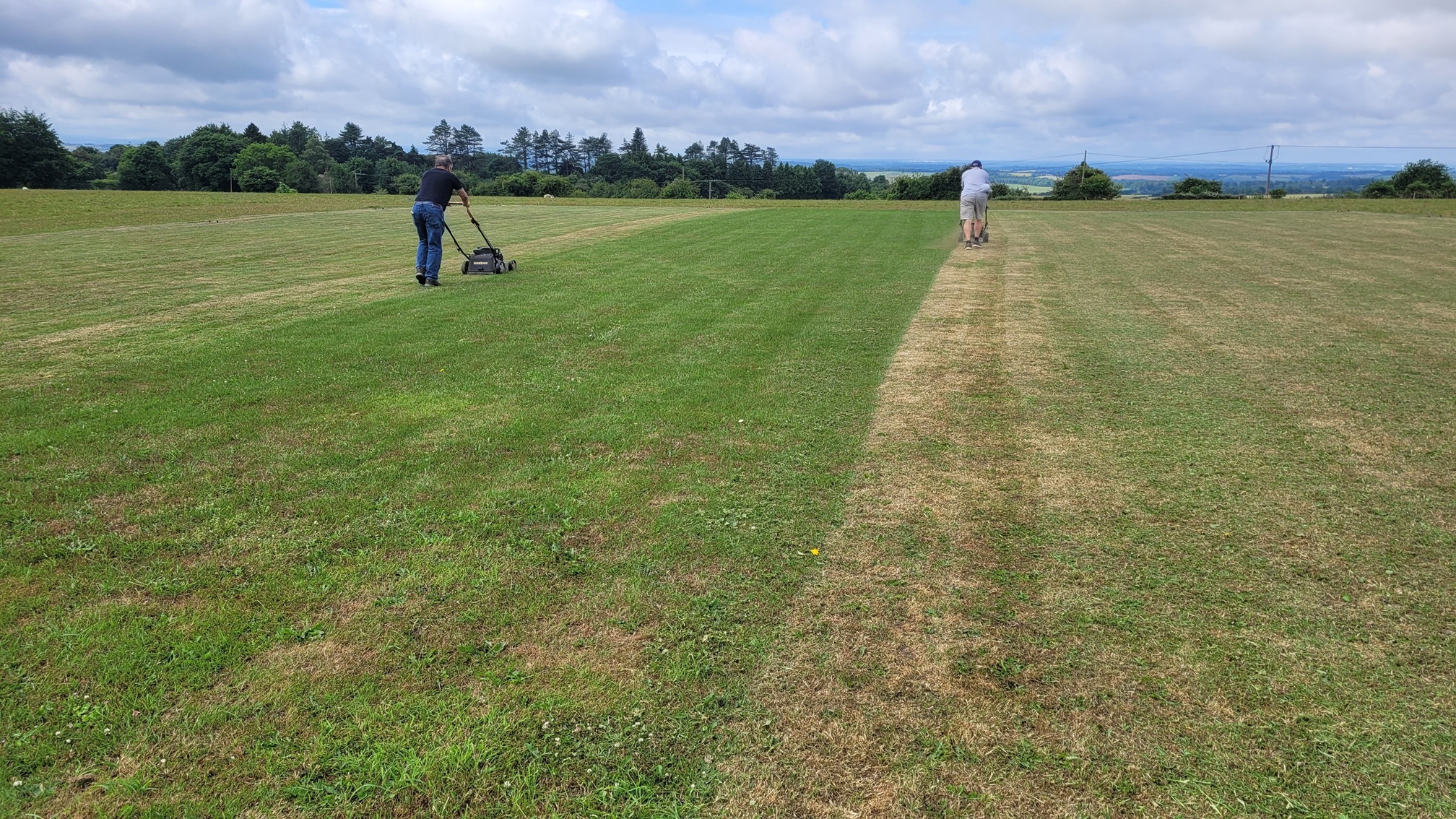
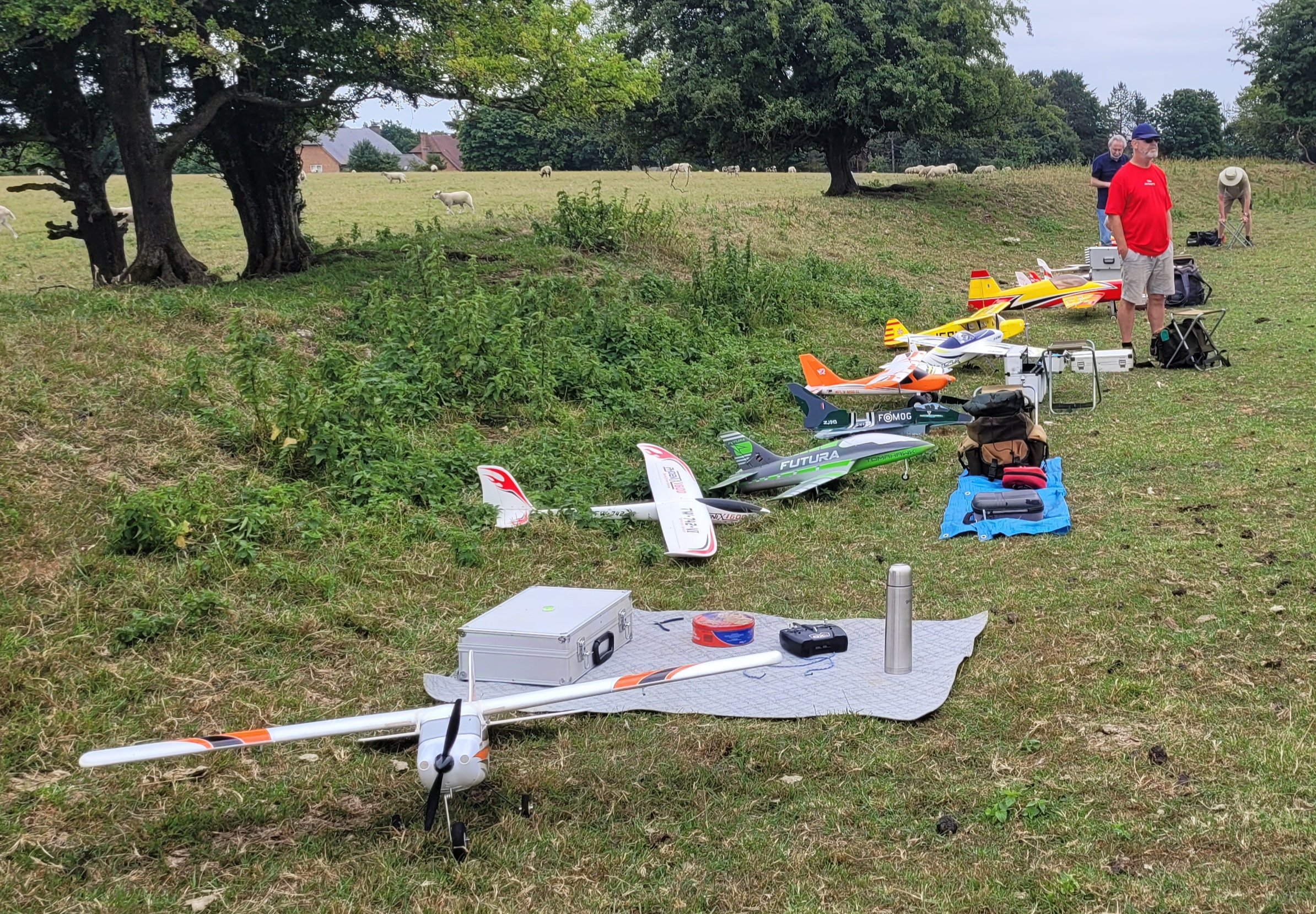 The bullocks have disappeared (to Sainsburys Taste the Difference I believe!) but several hundred sheep came and went a few times throughout June and left plenty of ‘presents’.
The bullocks have disappeared (to Sainsburys Taste the Difference I believe!) but several hundred sheep came and went a few times throughout June and left plenty of ‘presents’.
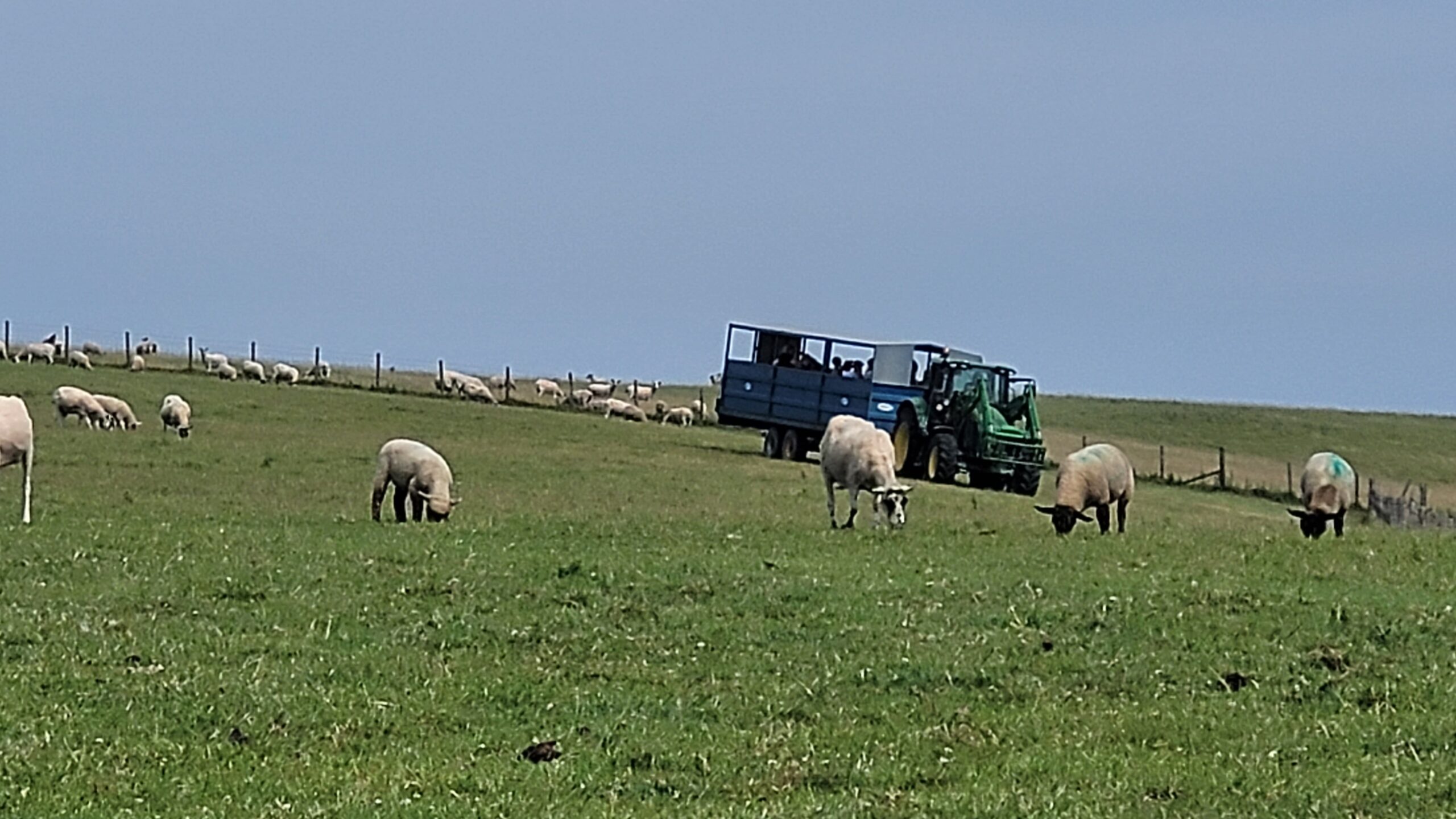 We also saw the farmers doing educational trips for school children, bringing them up to the field in a trailer towed by a tractor. We didn’t have trips like that when I was at school!
We also saw the farmers doing educational trips for school children, bringing them up to the field in a trailer towed by a tractor. We didn’t have trips like that when I was at school!
With good weather in June a few new models appeared at the patch. First up was Catapult King who brought along two new models, one being a ready to fly ‘toy’, a Sky Viper Vector.
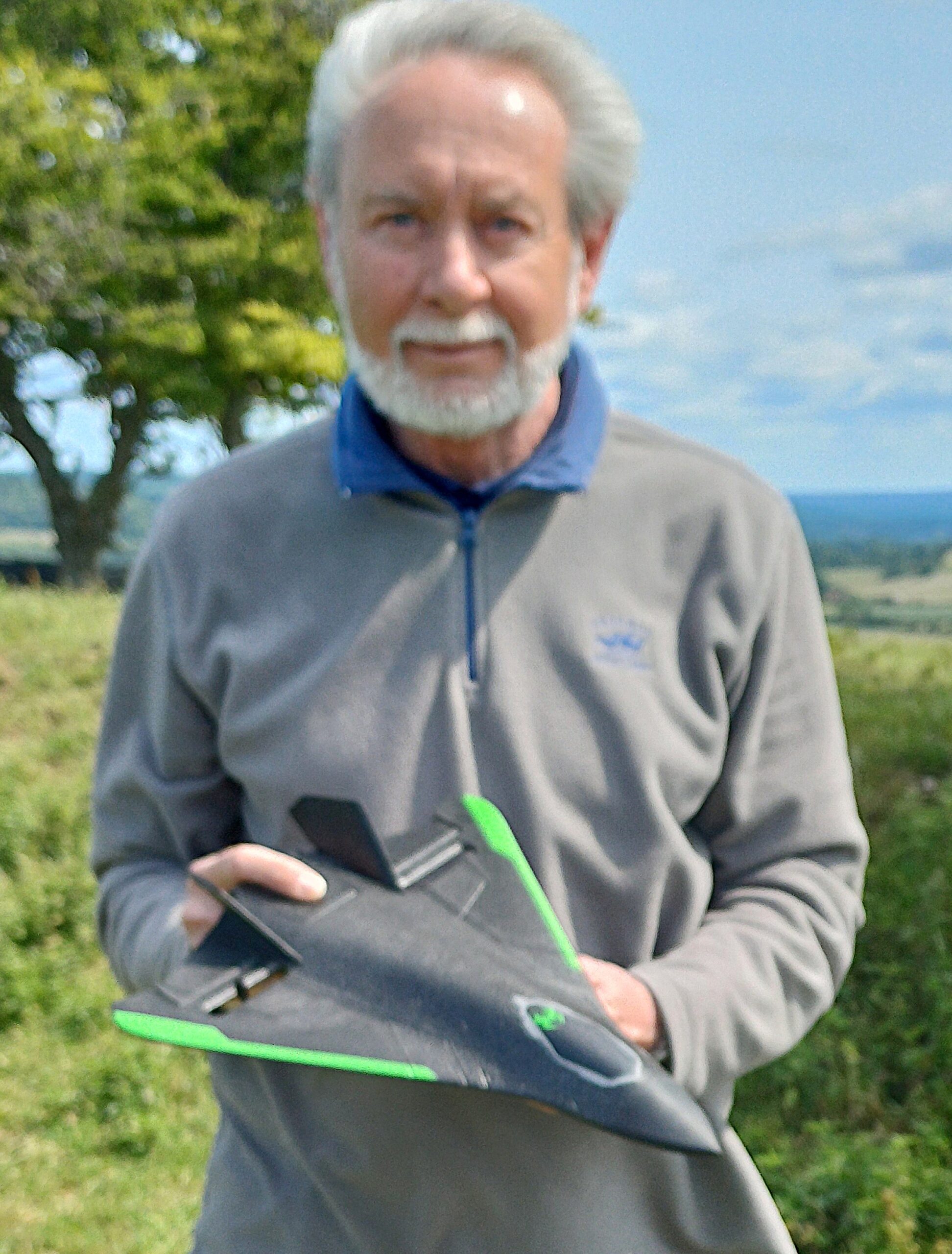 The Vector is the same as both Woody and Captain Slow got for Christmas and Woody has successfully flown his several times, but Captain Slow hasn’t rushed into flying his yet. It was a windy day when Catapult King flew his Viper but it handled the conditions well.
The Vector is the same as both Woody and Captain Slow got for Christmas and Woody has successfully flown his several times, but Captain Slow hasn’t rushed into flying his yet. It was a windy day when Catapult King flew his Viper but it handled the conditions well.
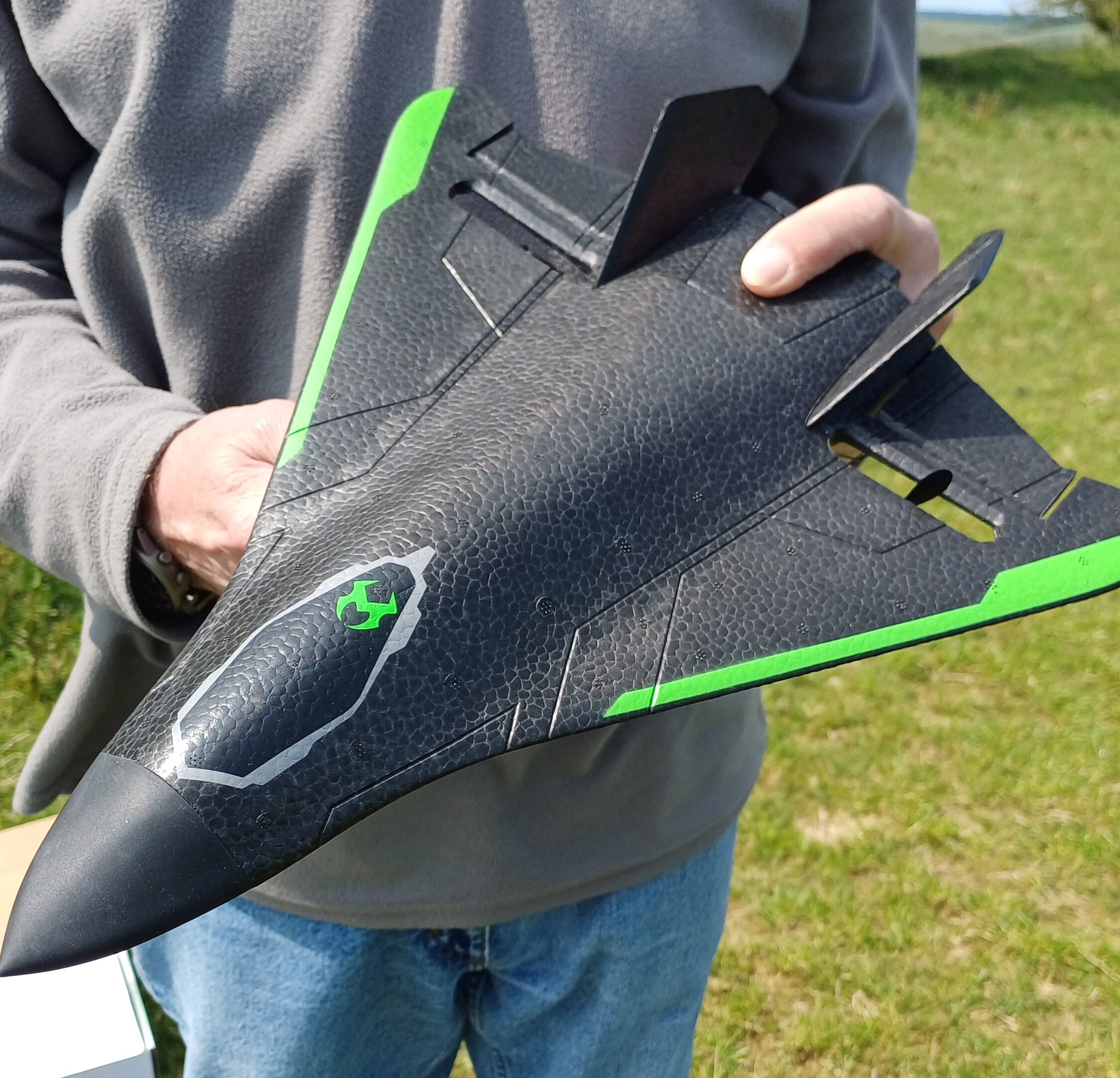 In the video you’ll see a big difference between the upwind and downwind speeds.
In the video you’ll see a big difference between the upwind and downwind speeds.
The second model that Catapult brought is much more interesting, it is a copy of an E-flite Pulse that he’s built from balsa, unlike an earlier Pulse copy that he’d built from Depron!
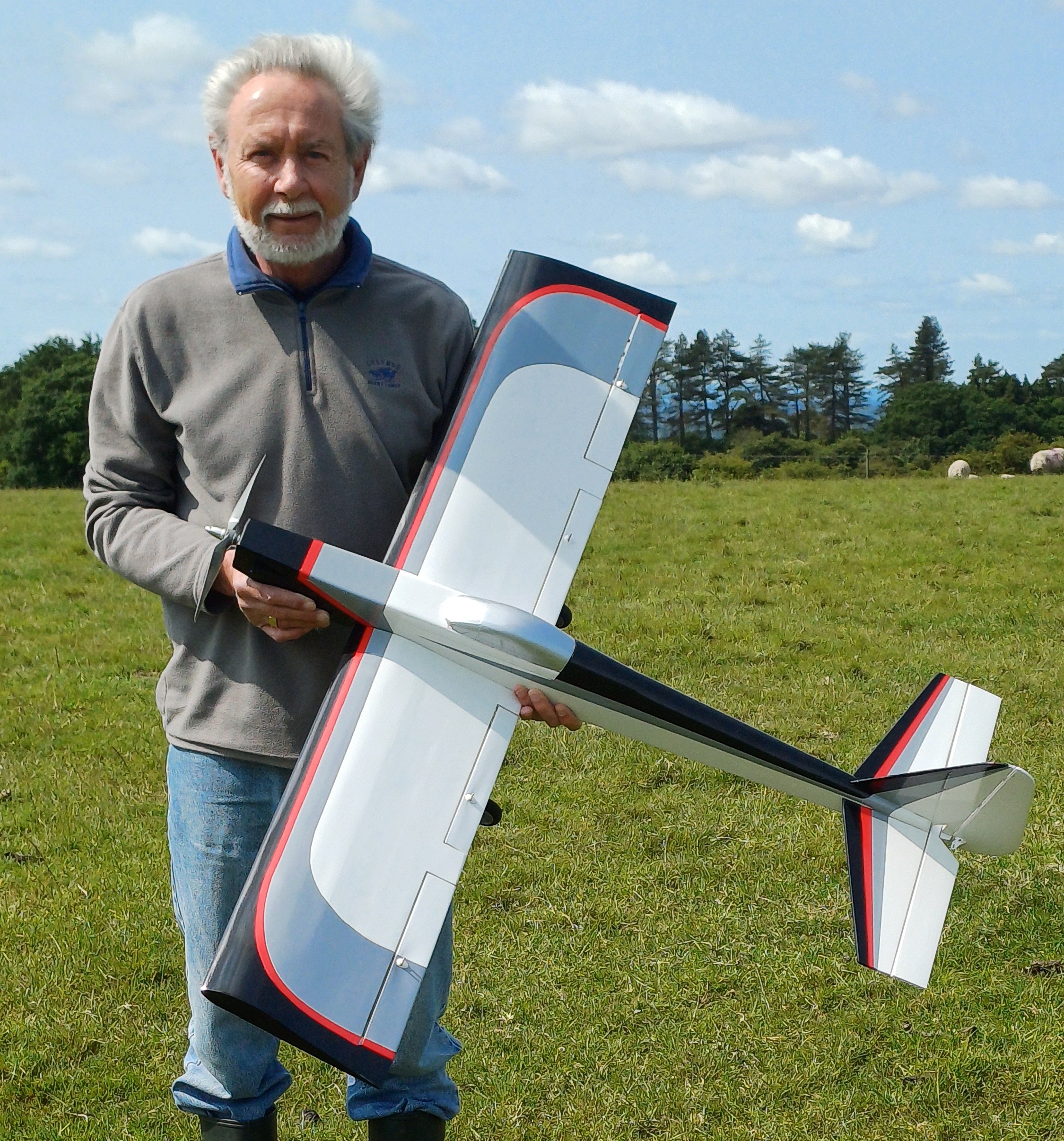 I asked Catapult for a few details: Amazingly this plane came in 200g lighter than the foam version so I used all the electrics from the old one. Good old HK900 servos for all control surfaces, Turnigy 4s 2650 battery, PropDrive 3530 900kv motor, HK 40amp ESC and a 10×6 APC prop (I think if all goes well this could go up to an 11×8).
I asked Catapult for a few details: Amazingly this plane came in 200g lighter than the foam version so I used all the electrics from the old one. Good old HK900 servos for all control surfaces, Turnigy 4s 2650 battery, PropDrive 3530 900kv motor, HK 40amp ESC and a 10×6 APC prop (I think if all goes well this could go up to an 11×8).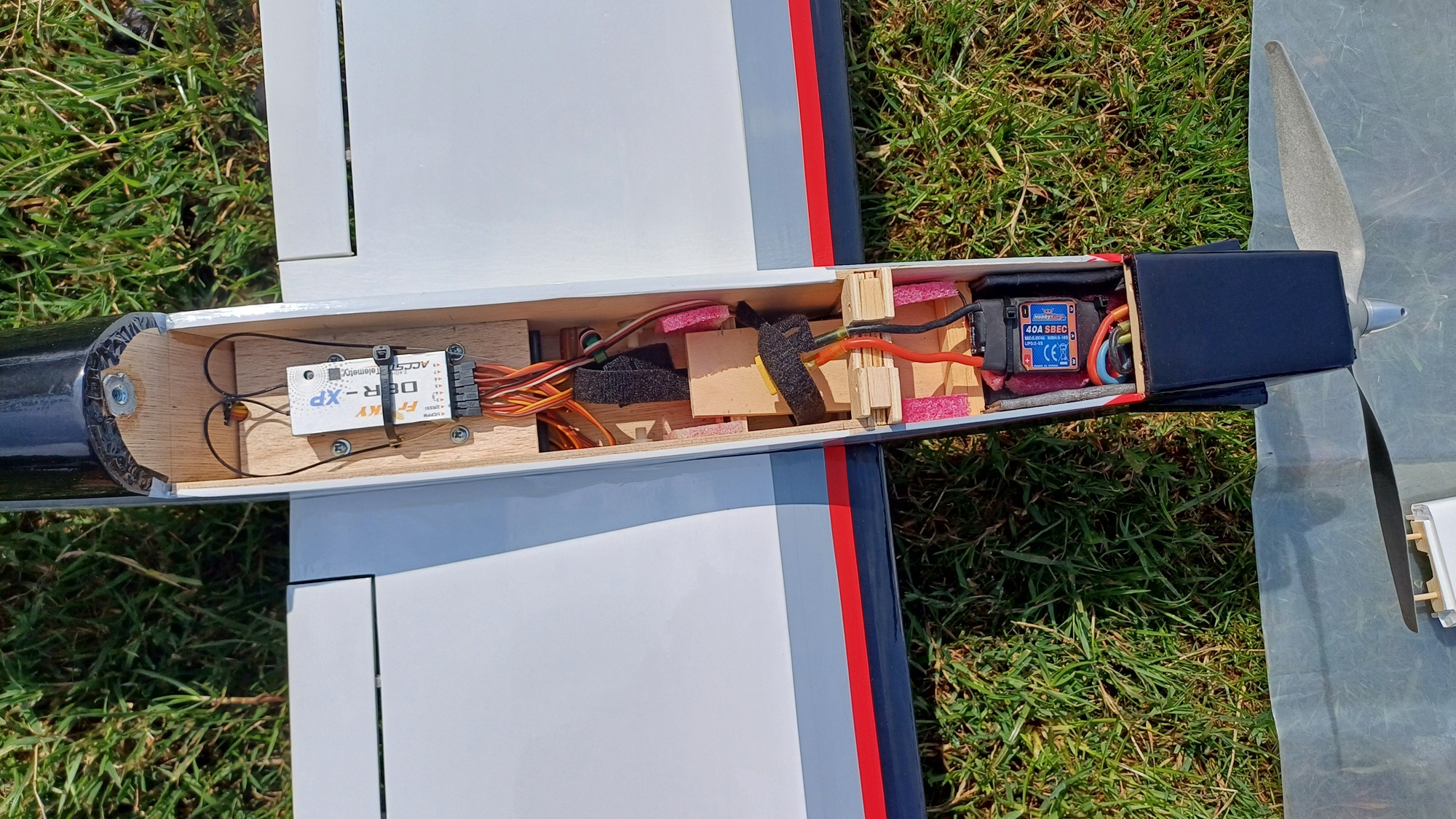
Catapult has made a lovely job of the model, and the quality of the covering, which is HobbyKing film, is amazing. He asked Dougal Entendre to do the maiden flight and this is what Dougal says about it: It took off OK, and was fine once I’d got sufficient down trim in. However, I commented that it looked like the wing was flexing a bit, and it seemed to have more dihedral than when it took off! It also dug in on a couple of turns, so I refrained from doing any aerobatics and got it down fairly sharpish.
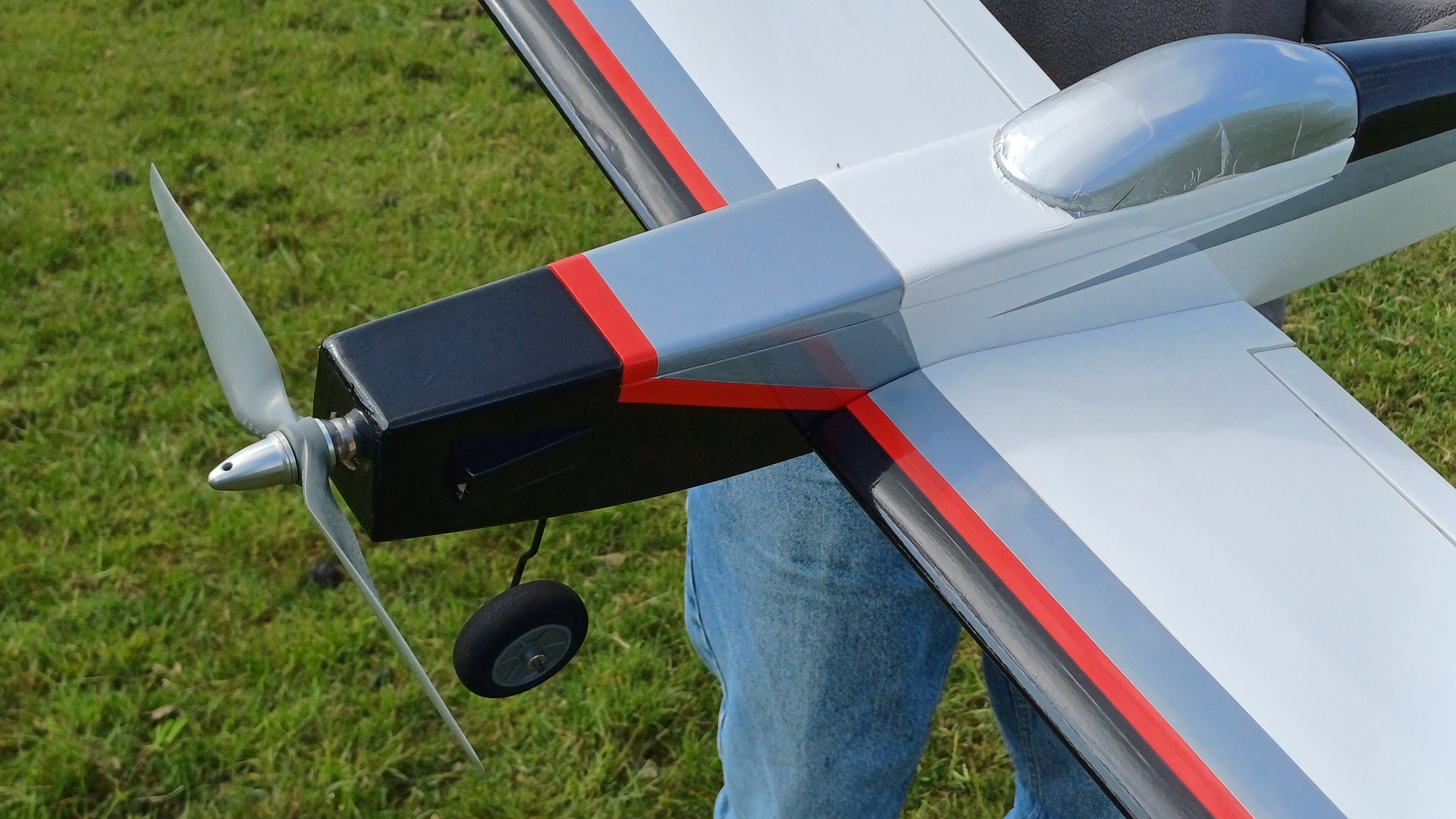 I asked Catapult if he’d found and cured the problem, this is his reply: I had had my concerns about the flex in the wing joints but stayed with it as I thought the dihedral looked more pleasing. However, as Dougal says one gust on the day and it was obvious they were not going to hold very long. It was just as well he landed as on inspecting the wings the original carbon tube had actually split inside the fuselage area. To fix this I cut an old aluminium arrow in half, filed a ‘V’ shape in one end, and then with one end in a drill and the other being guided by the carbon tube (and with a lot of trepidation) I literally drilled the arrow into the wing about three quarters of the way. Unfortunately I didn’t take any pictures. The wing itself though feels very solid.
I asked Catapult if he’d found and cured the problem, this is his reply: I had had my concerns about the flex in the wing joints but stayed with it as I thought the dihedral looked more pleasing. However, as Dougal says one gust on the day and it was obvious they were not going to hold very long. It was just as well he landed as on inspecting the wings the original carbon tube had actually split inside the fuselage area. To fix this I cut an old aluminium arrow in half, filed a ‘V’ shape in one end, and then with one end in a drill and the other being guided by the carbon tube (and with a lot of trepidation) I literally drilled the arrow into the wing about three quarters of the way. Unfortunately I didn’t take any pictures. The wing itself though feels very solid.
The next part was the join in the fuselage. I filled the old angled tubes with epoxy (let it cure) and then drilled a new hole directly through the original openings. Finding a carbon rod which fitted the inside of the arrows I then drilled out the original carbon tube from inside the arrows with the longest drill I had, even more scary than before. This goes about as far as the second rib in each wing. Refitting the wings already feels much better than before, but I still need to rework the first rib in each wing from angled to flat against the fuse. Then I think we’ll be ready for a proper test flight. Watch this space. Sadly nobody filmed the test flight so we’ll have to wait for test flight number two.
Not content with putting together his HobbyKing Voltigeur last month, 1066 has also started building another one to add to his collection: Having stumbled across a build video of the Angelwing Blink V2 I decided to take a look at the Angelwing website.
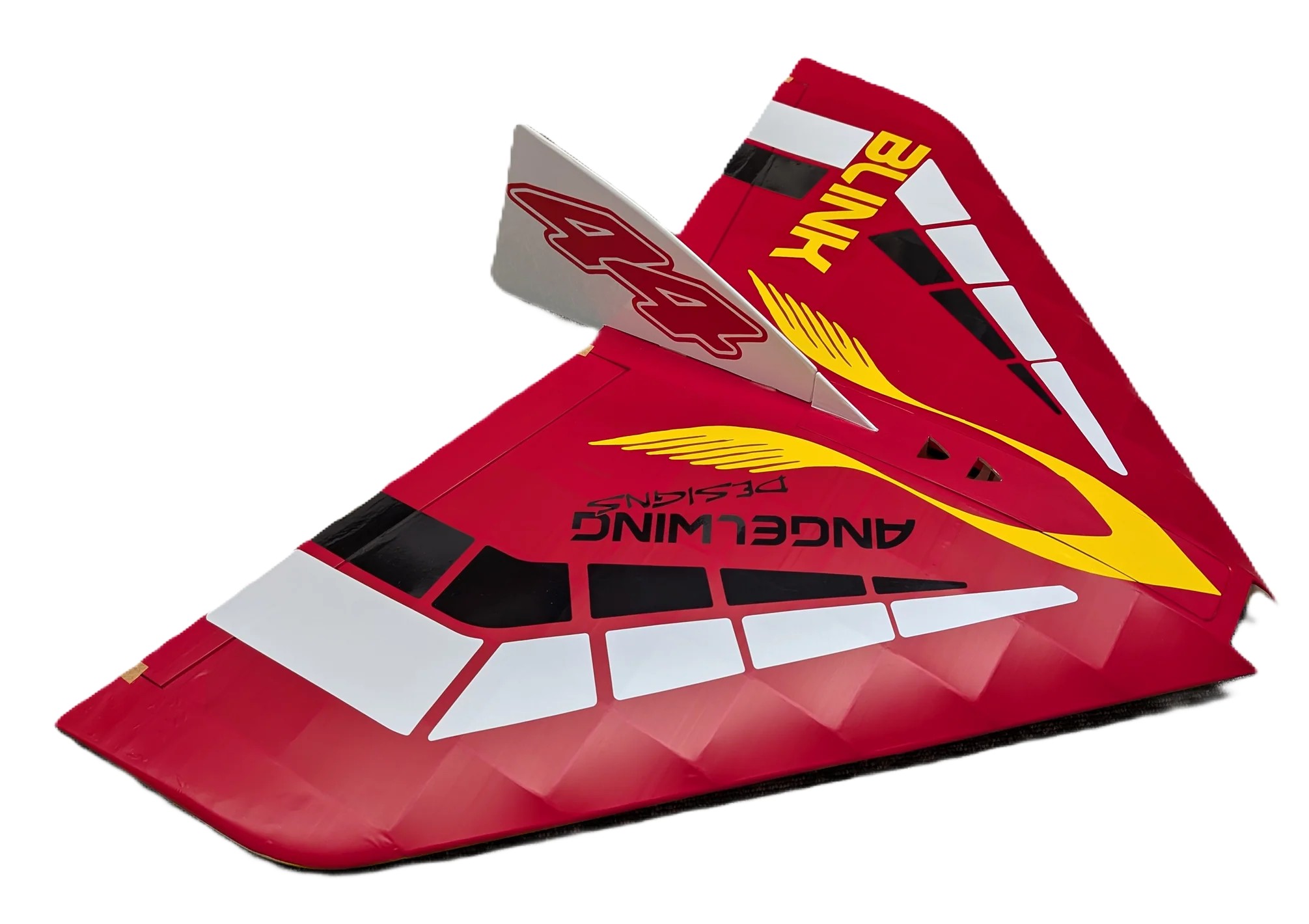 The Blink looked like an interesting and easy build, and for £60 delivered was not so expensive, so after putting one in my basket I ummed and ahhed for a couple of weeks before hitting the buy button. The kit arrived a couple of days later, wow the boxes seem to get smaller and smaller! For £60.00 you don’t get a lot, not even a plan or instructions, these have to be downloaded as a PDF, however they are really good, I’m assuming they are taken from the CAD drawings used in the design process.
The Blink looked like an interesting and easy build, and for £60 delivered was not so expensive, so after putting one in my basket I ummed and ahhed for a couple of weeks before hitting the buy button. The kit arrived a couple of days later, wow the boxes seem to get smaller and smaller! For £60.00 you don’t get a lot, not even a plan or instructions, these have to be downloaded as a PDF, however they are really good, I’m assuming they are taken from the CAD drawings used in the design process.
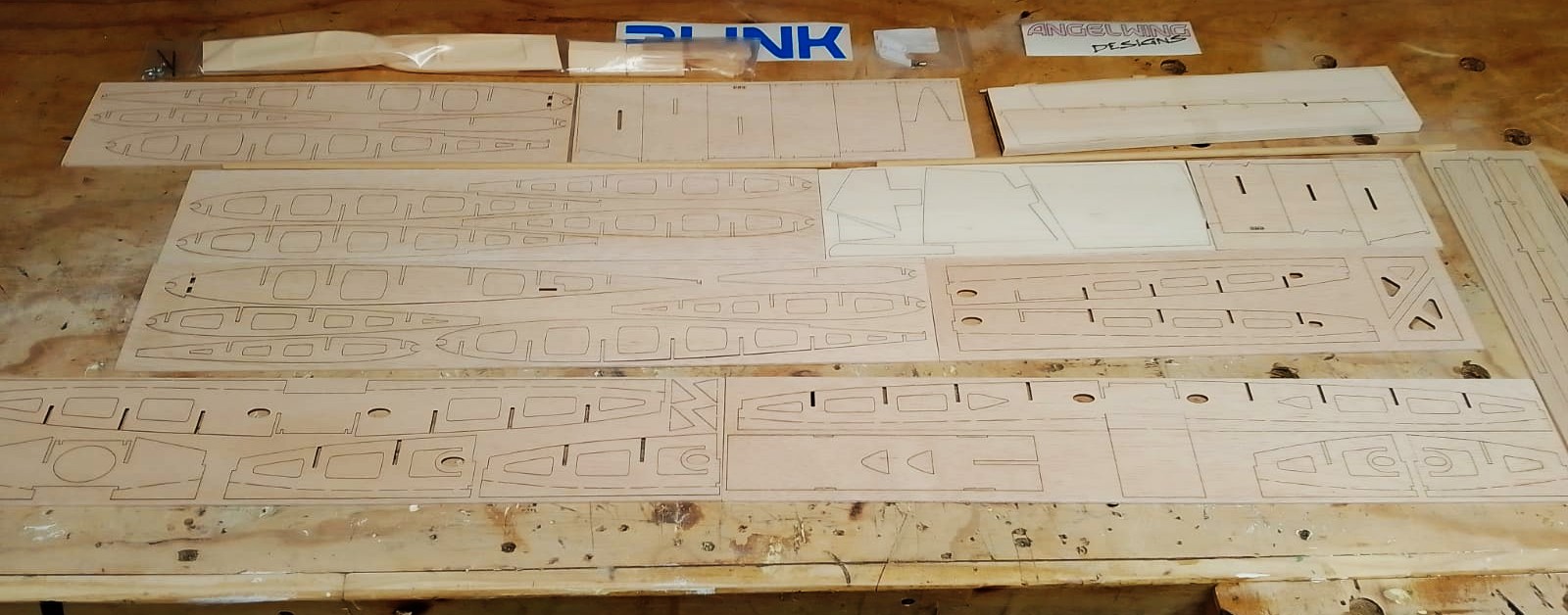
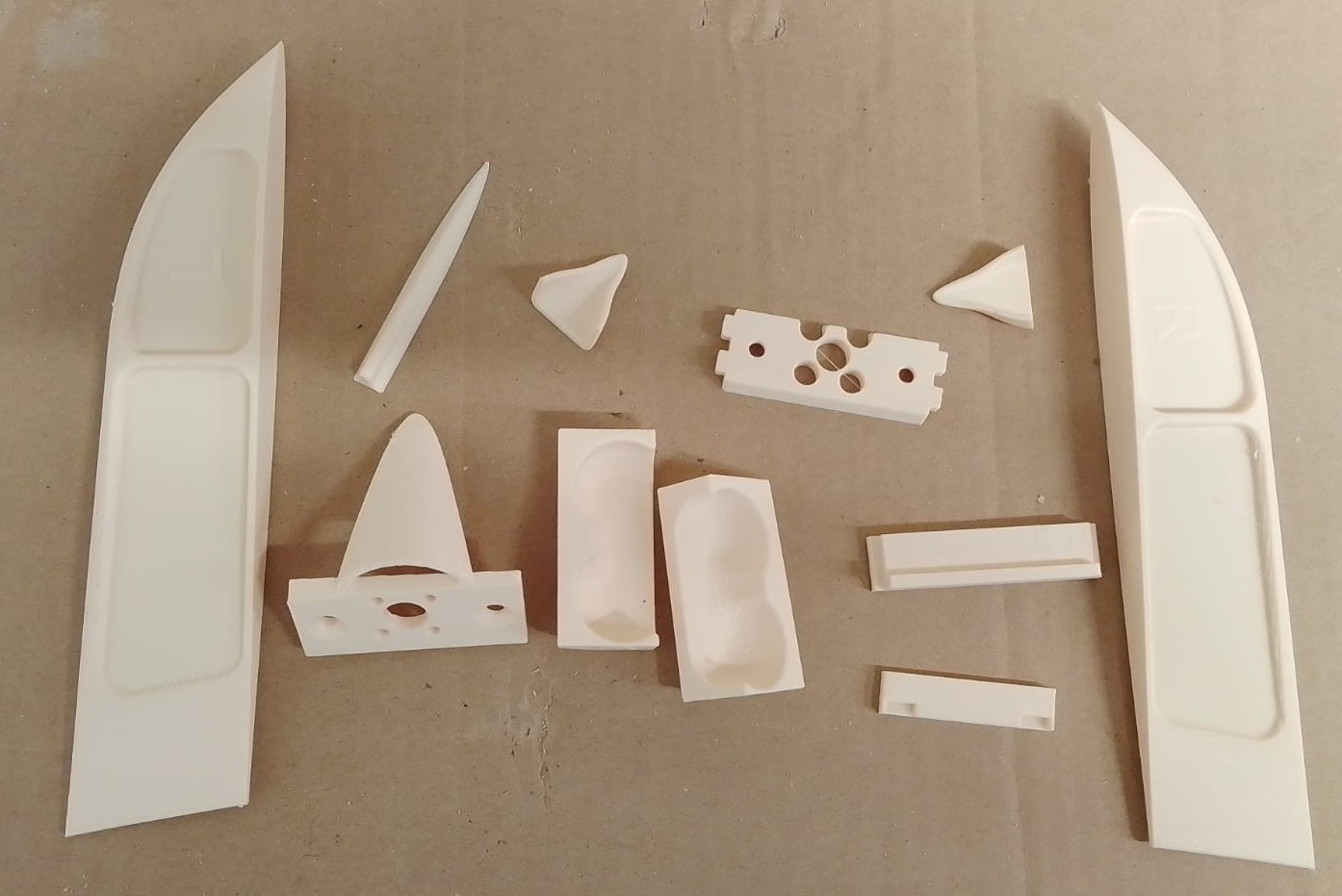 What you do get is a bunch of laser cut sheets of balsa, and a bag of 3D printed parts which includes the motor mount, wing tips, finger holds, rear hatch support, plus a couple of bits I’m not sure about yet. The laser cutting is some of the best I’ve seen, with some of the parts falling from the sheets just taking them out of the box. However when I started building there was one sheet where the laser hadn’t quite penetrated so a knife was required and I did break a few bits on the grain, mainly at the leading edge.
What you do get is a bunch of laser cut sheets of balsa, and a bag of 3D printed parts which includes the motor mount, wing tips, finger holds, rear hatch support, plus a couple of bits I’m not sure about yet. The laser cutting is some of the best I’ve seen, with some of the parts falling from the sheets just taking them out of the box. However when I started building there was one sheet where the laser hadn’t quite penetrated so a knife was required and I did break a few bits on the grain, mainly at the leading edge.
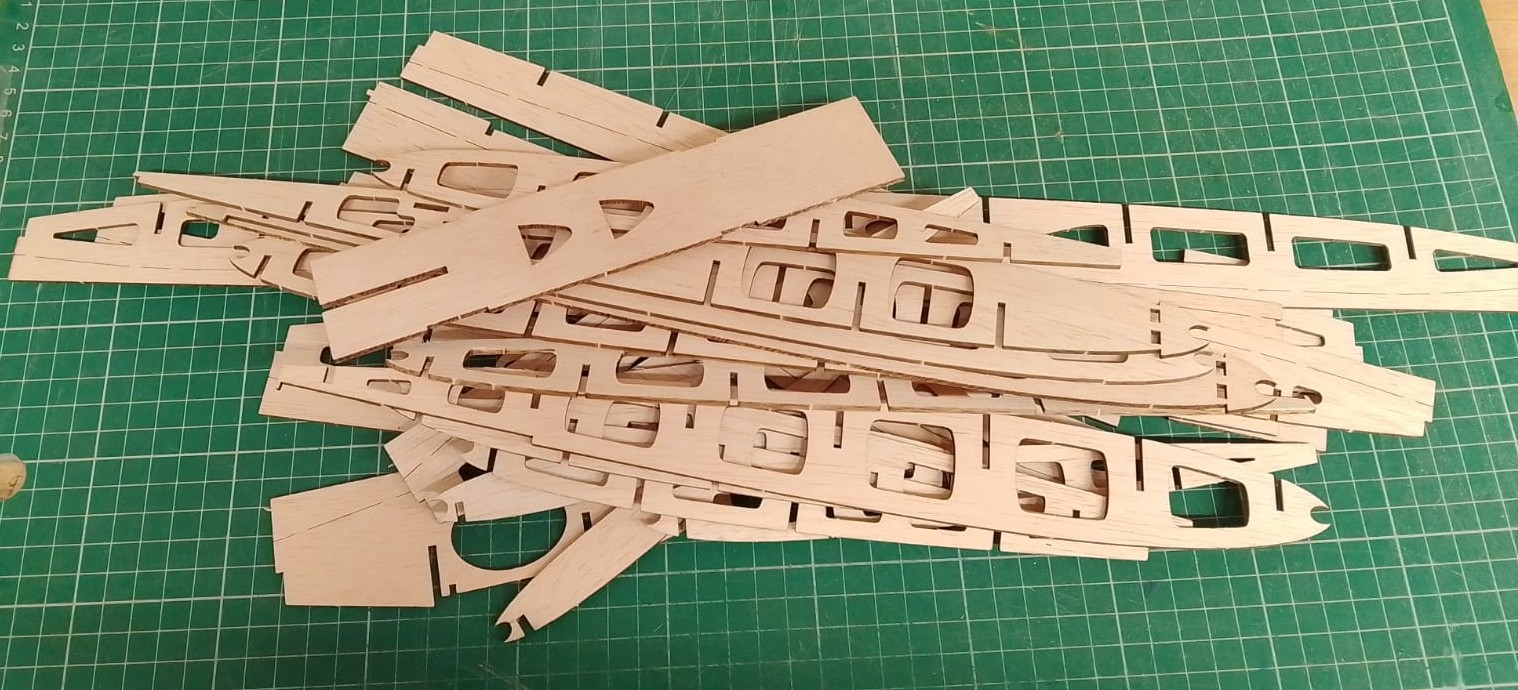 Now I don’t know about you lot, but my old lady is always nagging me about not reading instructions, so why break the habit of a lifetime, besides, I had looked at all the lovely pictures! When I build this sort of kit I like to remove all the parts from their respective sheets first, OK so far, but what I hadn’t noticed was that all the spar components have built in sacrificial jigging so, anyone like to guess how many jigging parts had to be rescued from the bin and be stuck back on, before I realised my mistake?
Now I don’t know about you lot, but my old lady is always nagging me about not reading instructions, so why break the habit of a lifetime, besides, I had looked at all the lovely pictures! When I build this sort of kit I like to remove all the parts from their respective sheets first, OK so far, but what I hadn’t noticed was that all the spar components have built in sacrificial jigging so, anyone like to guess how many jigging parts had to be rescued from the bin and be stuck back on, before I realised my mistake?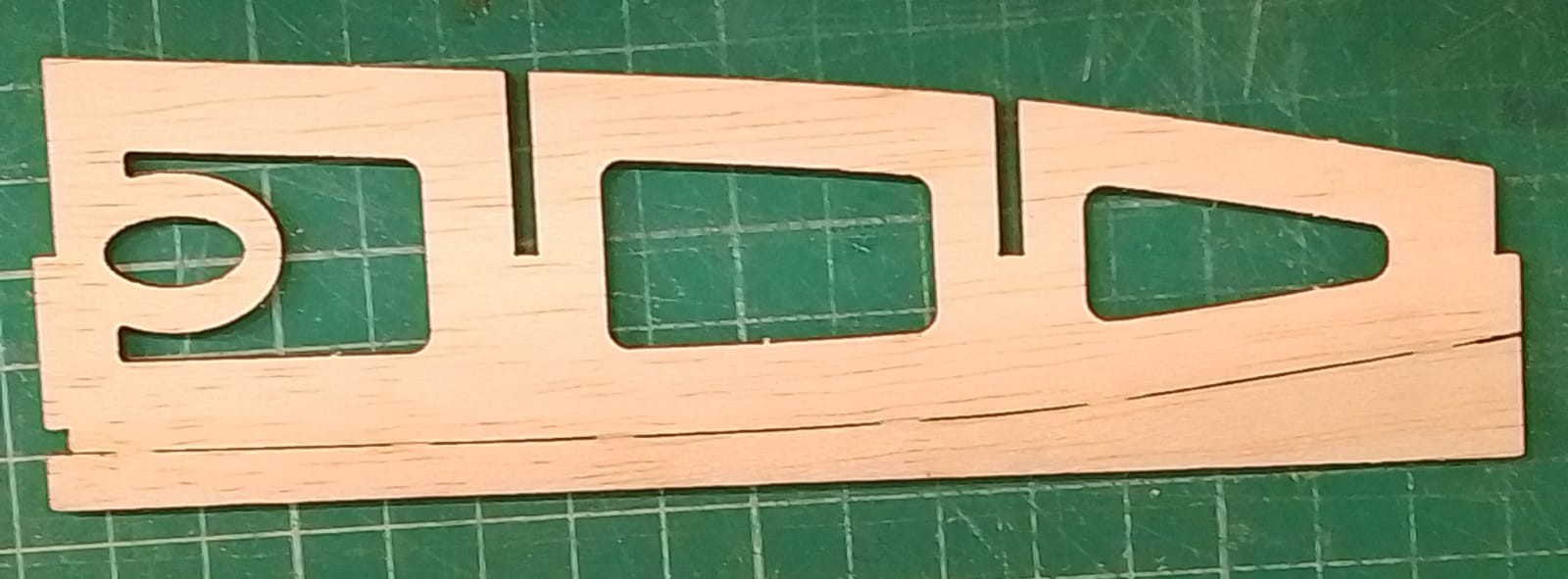
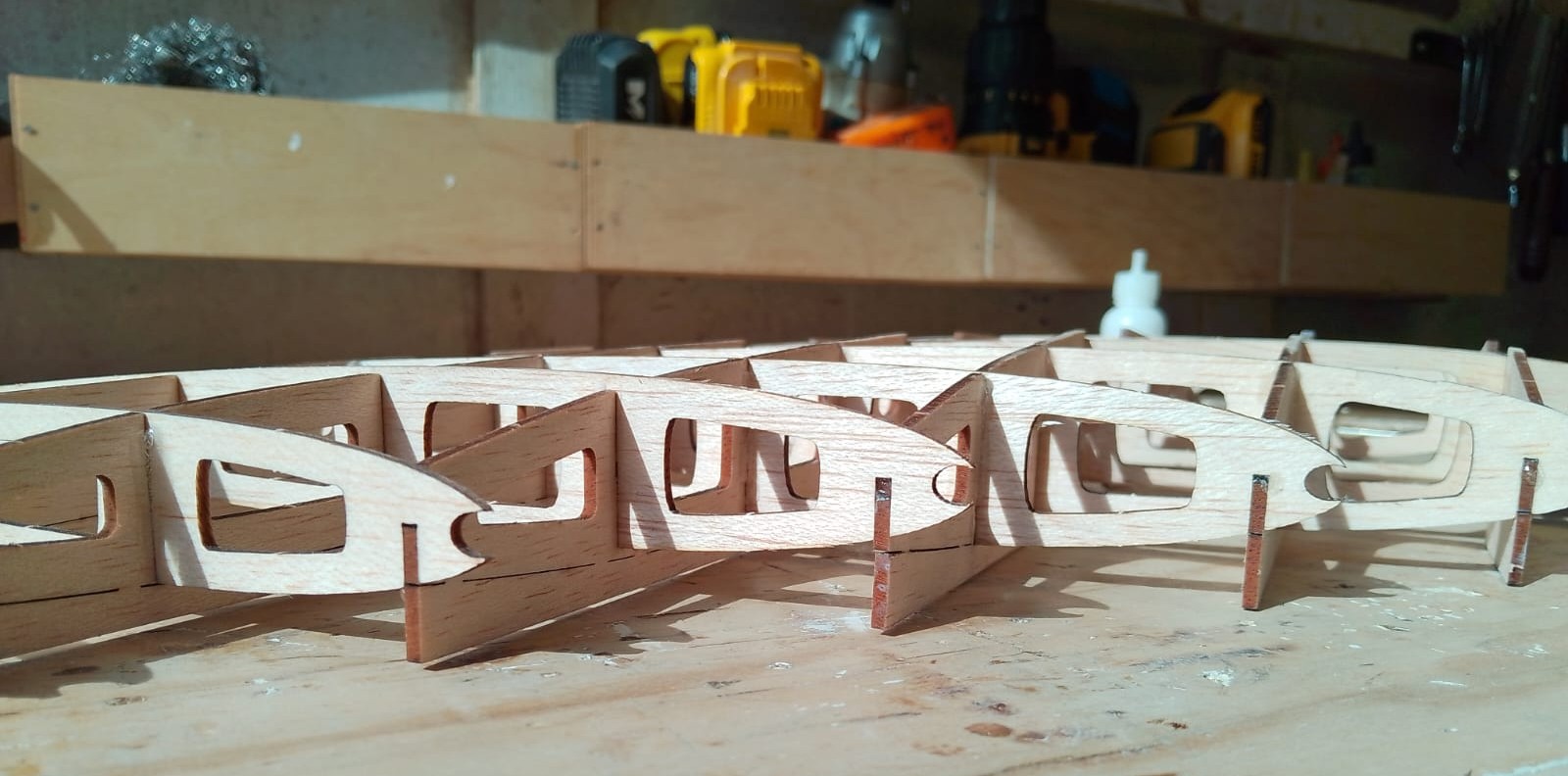 The accuracy of the laser cutting, and the self-jigging design means the model goes together very quickly, I opted to use wood glue in all the slots, backed up with dots of super glue to act as pins while the wood glue dries. Having dry assembled 75% of the wing to check it went together before committing to glue it became very apparent this was a very stable structure, so if I had some very thin glue available, I would have probably slotted it all together dry, then run the glue in. My thoughts so far, well the quality is fantastic, but the model is quite a bit smaller than I thought, so is it good value? So far I think it is, even if I could cut balsa to the accuracy the laser can, it would take days, and it’s very obvious the manufacturer has put a lot of effort into the design.
The accuracy of the laser cutting, and the self-jigging design means the model goes together very quickly, I opted to use wood glue in all the slots, backed up with dots of super glue to act as pins while the wood glue dries. Having dry assembled 75% of the wing to check it went together before committing to glue it became very apparent this was a very stable structure, so if I had some very thin glue available, I would have probably slotted it all together dry, then run the glue in. My thoughts so far, well the quality is fantastic, but the model is quite a bit smaller than I thought, so is it good value? So far I think it is, even if I could cut balsa to the accuracy the laser can, it would take days, and it’s very obvious the manufacturer has put a lot of effort into the design.
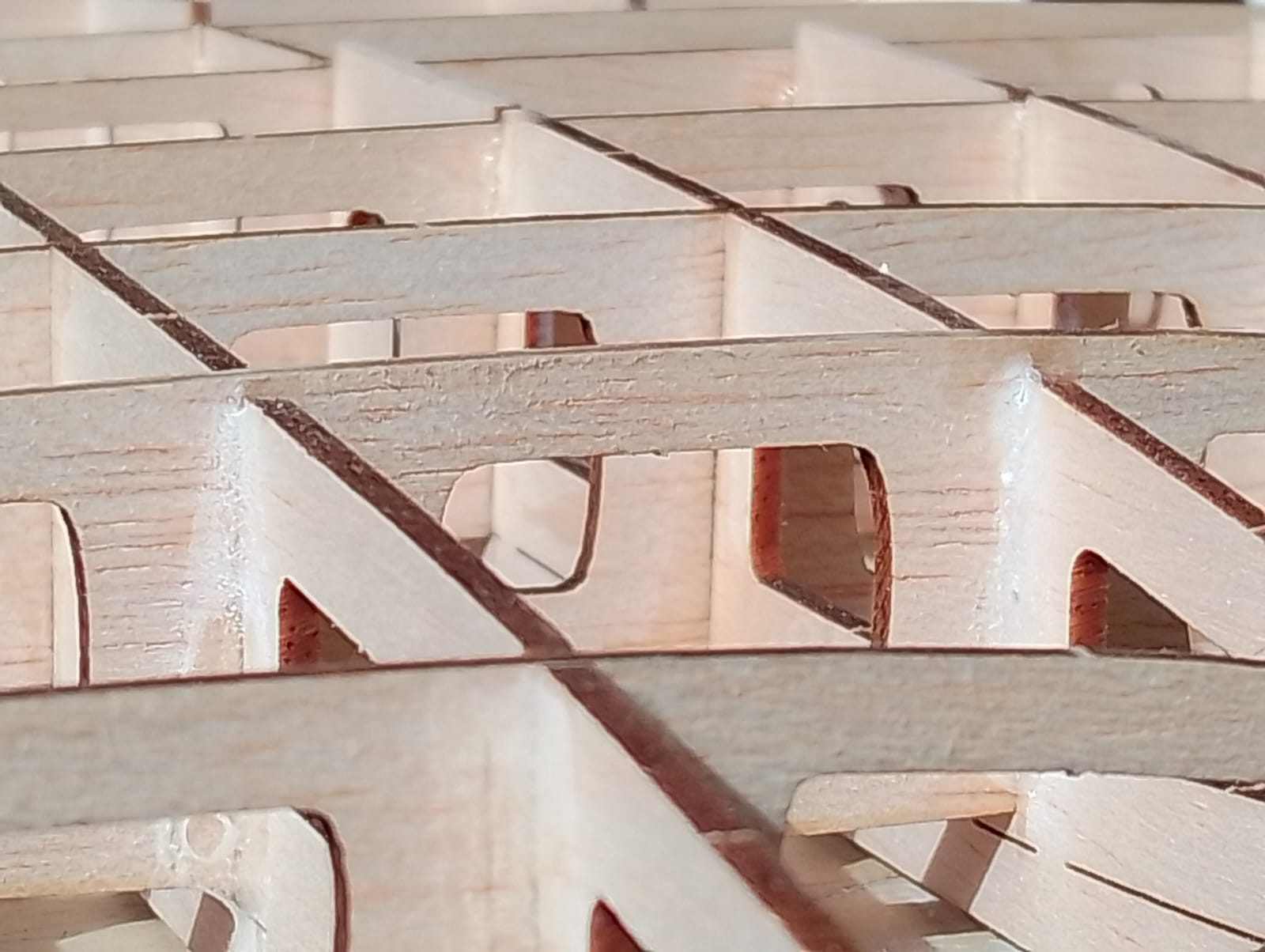
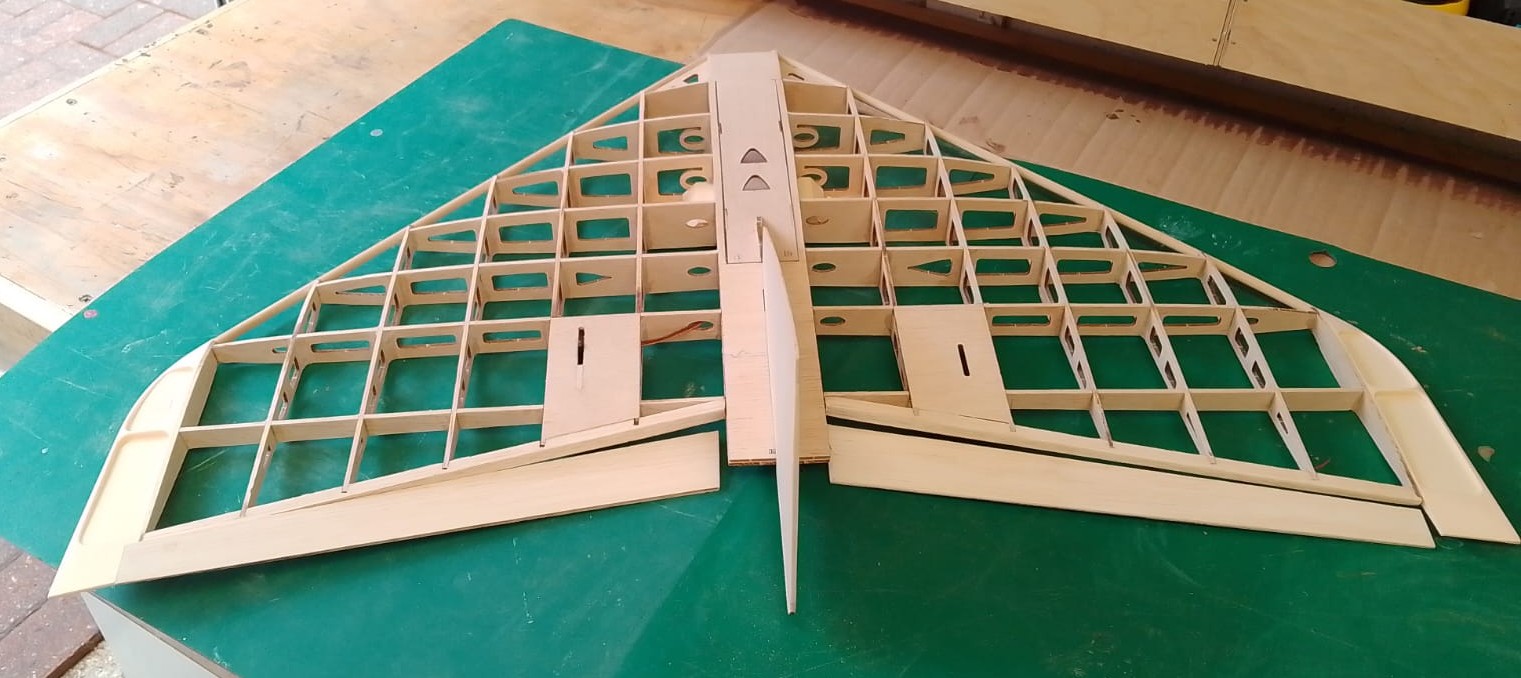 Let’s hope it fly’s as well as it is going together. Thanks 1066, looking forward to it flying.
Let’s hope it fly’s as well as it is going together. Thanks 1066, looking forward to it flying.
Dwayne Pipe will be running the club Annual Chuck Glider Competition at 7.30pm on Wednesday 9th July. It will be held at the Buriton playing fields rather than our patch as it will hopefully be less windy and won’t involve a half mile retrieval after every flight! Dwayne has set an alternative date of 16th July if the weather is bad but I can’t make the 16th so I say we’re having the comp on the 9th even if it’s pouring with rain and blowing a gale! There will be two classes, normal chuck glider, and catapult launched glider, with the catapult being provided by Dwayne. It’s always a fun evening so come along and join in.
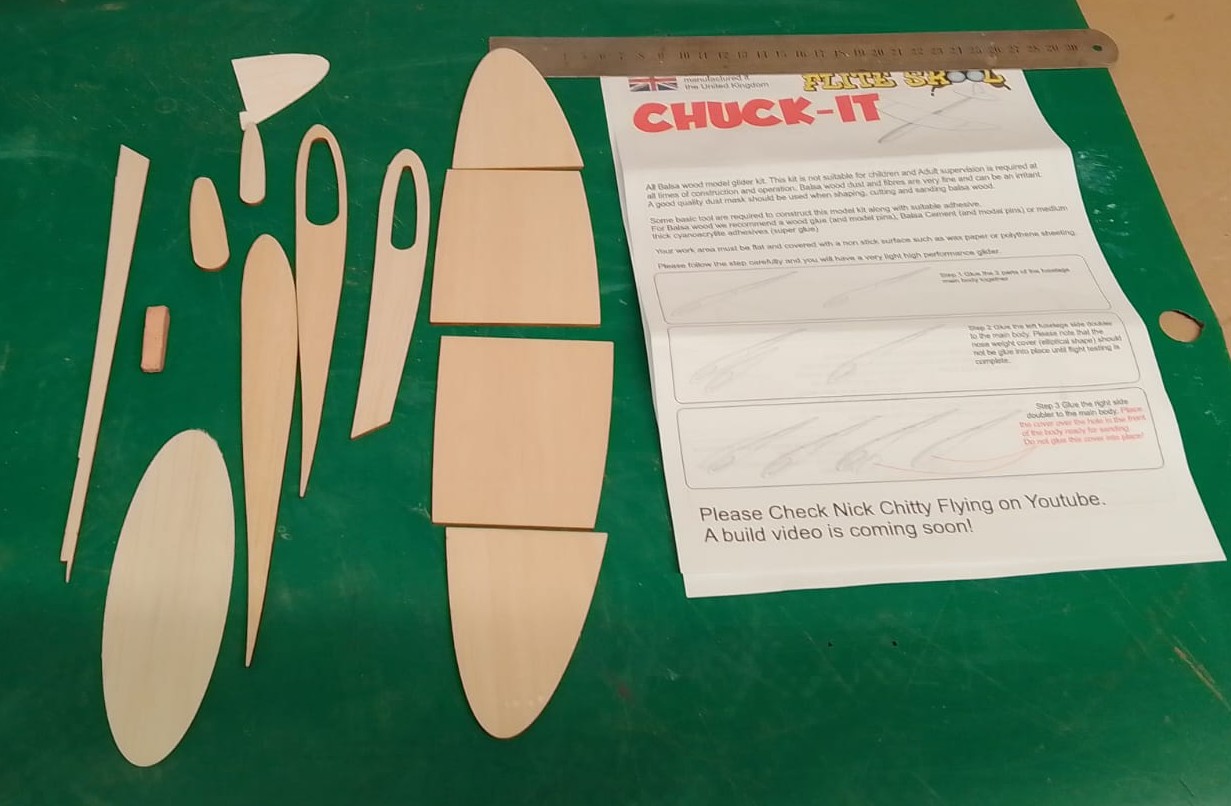 1066 has never taken part in the chuck glider comp but this year he’s got one on the building board and says he intends to be there and win the trophy. He even sent me a photo of the kit he’s building so we know exactly what we’ll be up against.
1066 has never taken part in the chuck glider comp but this year he’s got one on the building board and says he intends to be there and win the trophy. He even sent me a photo of the kit he’s building so we know exactly what we’ll be up against.
Dougal Entendre has been busy getting a Sportster that was a second-hand purchase ready for flight, here’s his report: Back when we had the club auction for John Bourne’s planes, there were no takers for his large Sportster. The airframe had to go somewhere, so I paid the club a tenner and had it decorating the ceiling in my hangar.
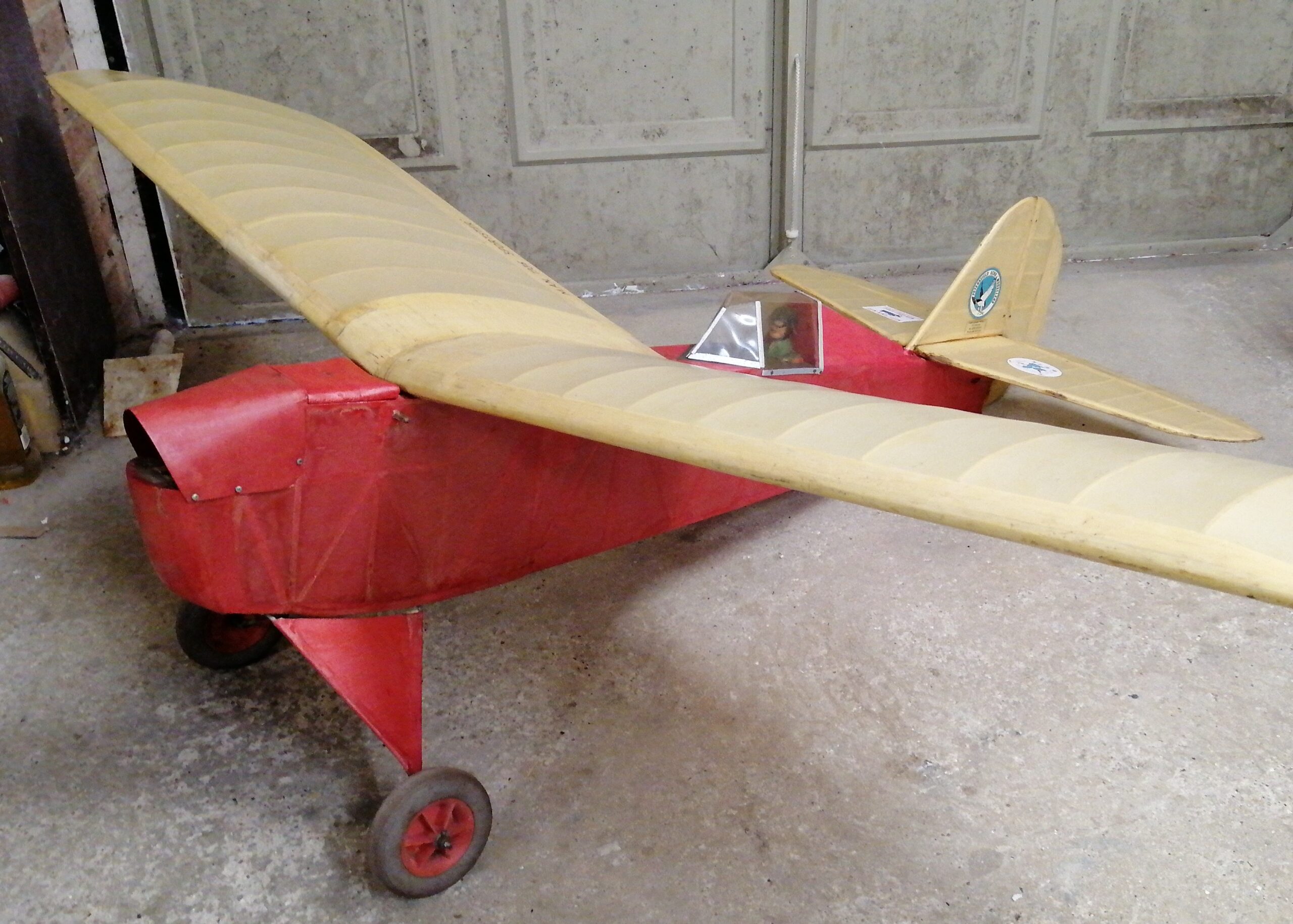
 A few weeks ago I added a motor and ESC, and took it to the patch. 1066 said that I was unlikely to get my usual adrenaline fix from it, but it turned out to be quite eventful!
A few weeks ago I added a motor and ESC, and took it to the patch. 1066 said that I was unlikely to get my usual adrenaline fix from it, but it turned out to be quite eventful!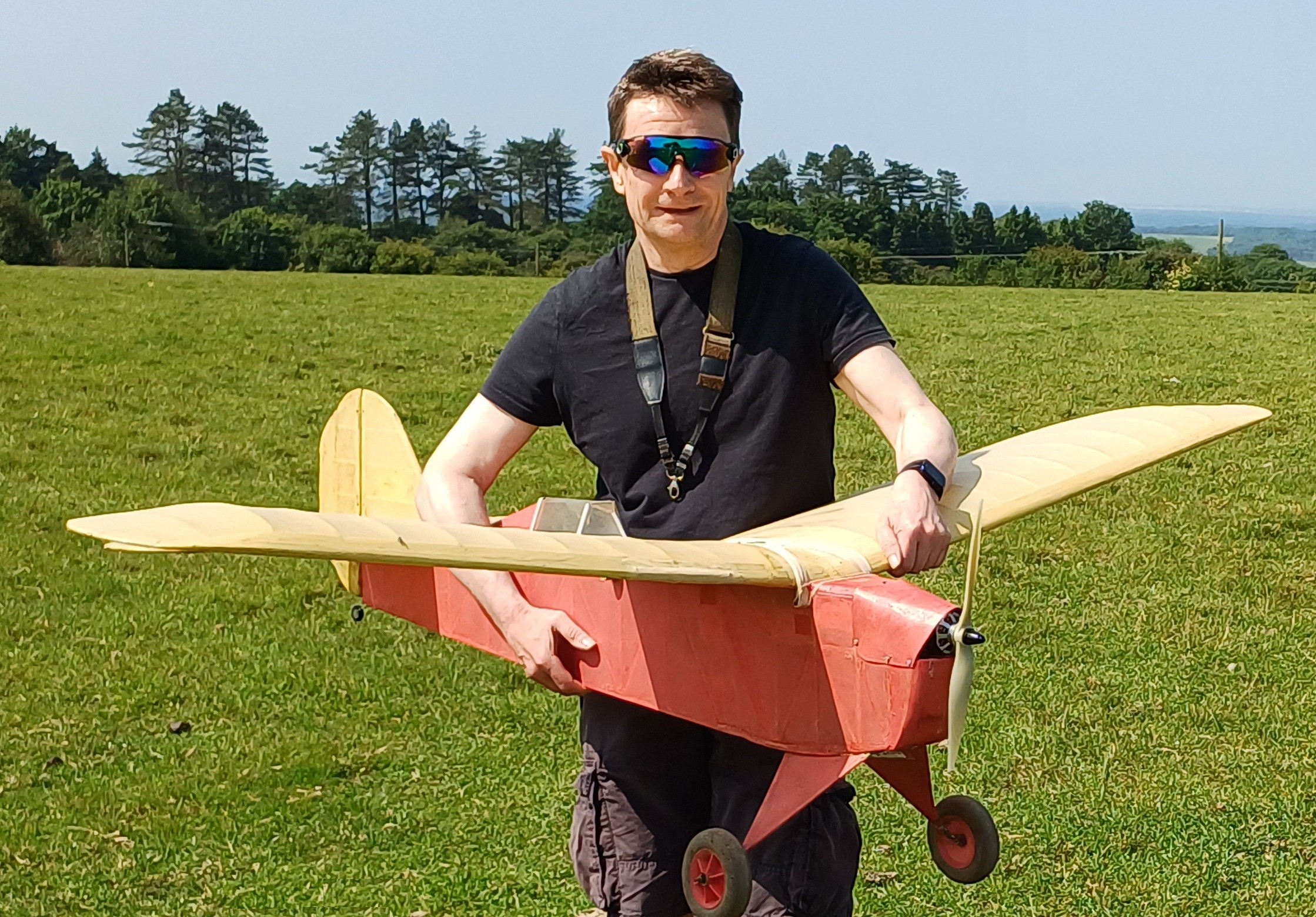
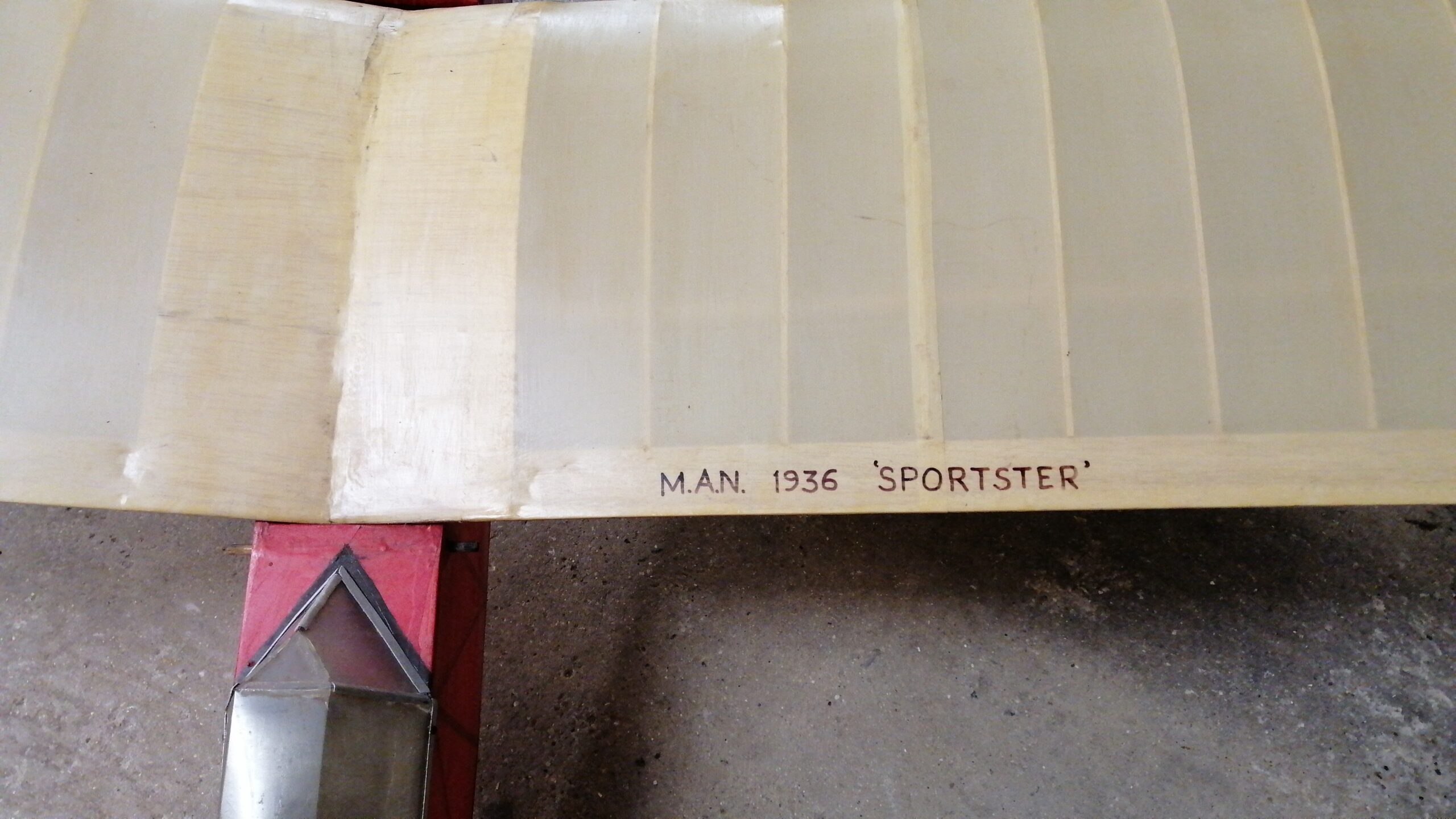 To backtrack; it’s a 1936 design from Model Aircraft News, about 73″ span, and the plan is available on Outerzone. It was beautifully built and covered in what I think is Solartex, with just rudder and elevator controls. It’s got John Bourne’s phone number on it from before it changed to an 01 dialling code, so that dates the airframe to before 1995!
To backtrack; it’s a 1936 design from Model Aircraft News, about 73″ span, and the plan is available on Outerzone. It was beautifully built and covered in what I think is Solartex, with just rudder and elevator controls. It’s got John Bourne’s phone number on it from before it changed to an 01 dialling code, so that dates the airframe to before 1995!
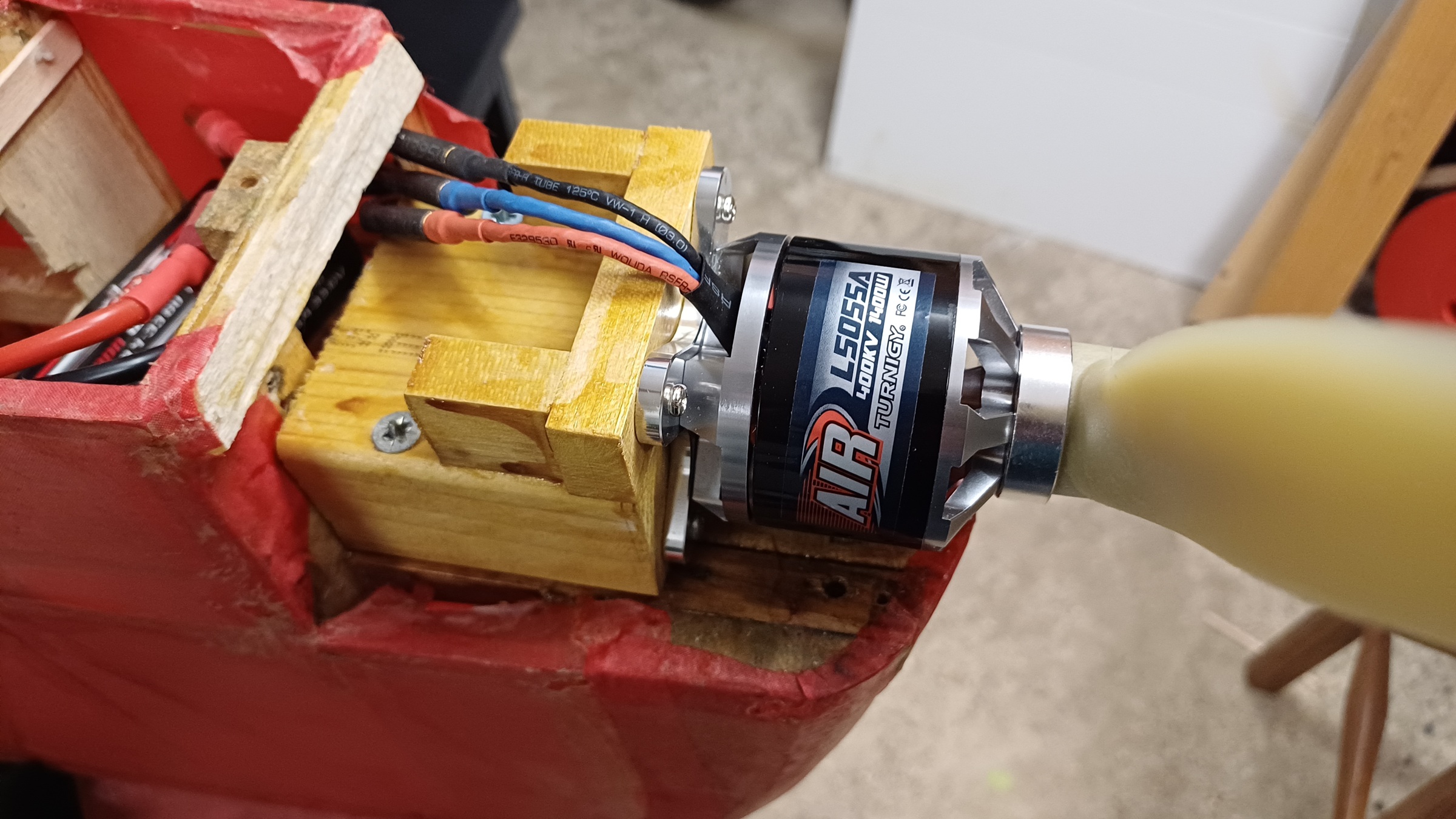 I added a 5055 400kV motor, 80A ESC and a 13 inch prop, with a 6s 5000mAh pack from my Velox. On take-off, it was immediately apparent that it had plenty of power, but needed nearly full down trim. The rudder was powerful, but the plane had a tendency to wallow from side to side, which can be seen in the video. I think it’s due to all the dihedral and the short moment arm. After 5 minutes I landed, flipping it over in the wind, but no damage. Remaining battery capacity: 85%!
I added a 5055 400kV motor, 80A ESC and a 13 inch prop, with a 6s 5000mAh pack from my Velox. On take-off, it was immediately apparent that it had plenty of power, but needed nearly full down trim. The rudder was powerful, but the plane had a tendency to wallow from side to side, which can be seen in the video. I think it’s due to all the dihedral and the short moment arm. After 5 minutes I landed, flipping it over in the wind, but no damage. Remaining battery capacity: 85%!
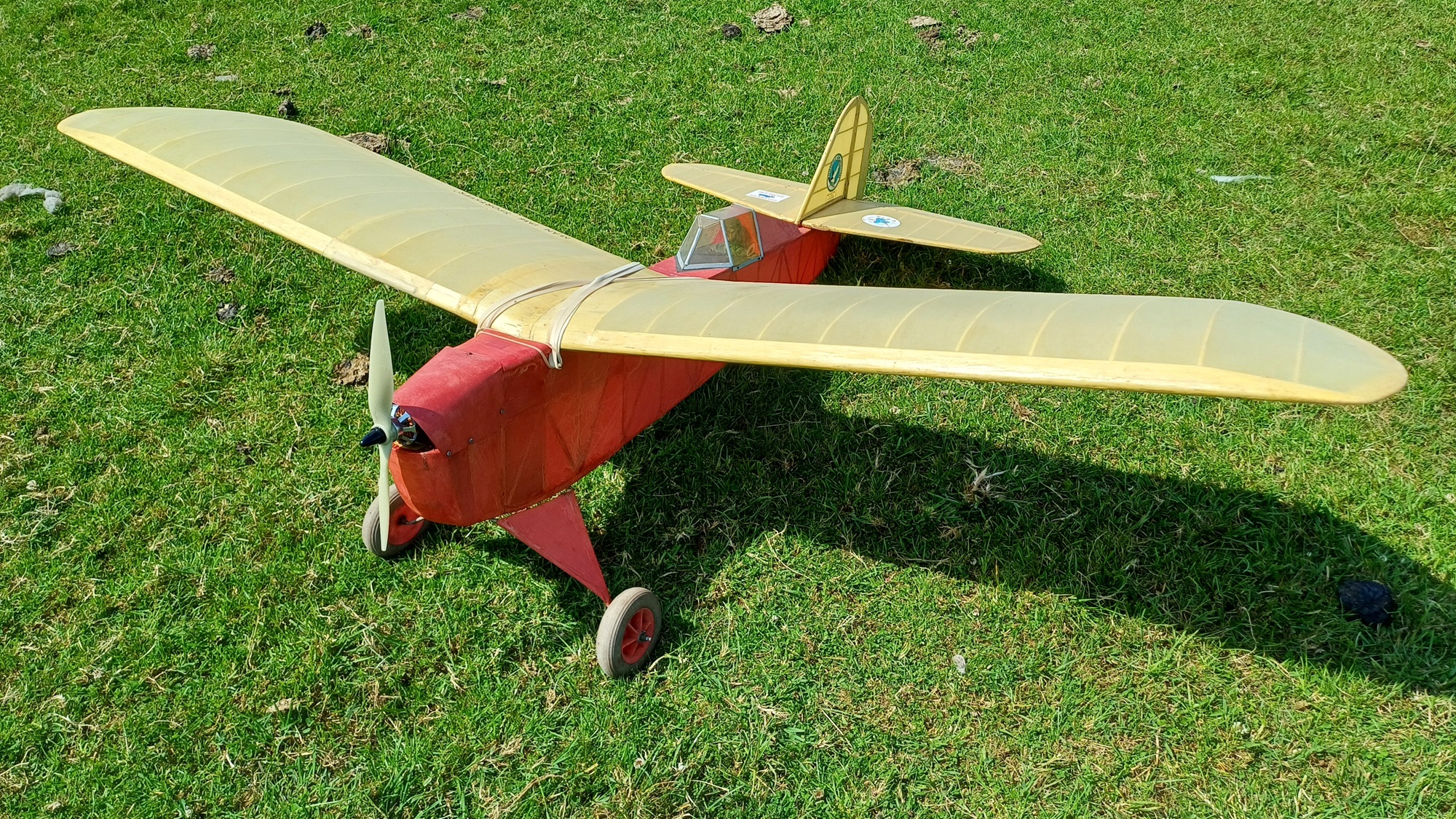 After winding in a load of down elevator I flew it again. After a minute or two I dared to try a loop, but got very violent tail flutter as it pulled out. I throttled back quickly and found I had no elevator control. I turned round using rudder and braced for disaster, but in the event it landed downwind about half way across the field, and didn’t even flip over! On inspecting the damage, I found the elevator control horn had broken off, and the violent flutter had broken the tailplane in the middle (the Solartex held it together well enough for the landing!). I’m not sure what to do now. I could strengthen the tail and move the elevator servo down to the back of the fuselage to eliminate pushrod flex.
After winding in a load of down elevator I flew it again. After a minute or two I dared to try a loop, but got very violent tail flutter as it pulled out. I throttled back quickly and found I had no elevator control. I turned round using rudder and braced for disaster, but in the event it landed downwind about half way across the field, and didn’t even flip over! On inspecting the damage, I found the elevator control horn had broken off, and the violent flutter had broken the tailplane in the middle (the Solartex held it together well enough for the landing!). I’m not sure what to do now. I could strengthen the tail and move the elevator servo down to the back of the fuselage to eliminate pushrod flex.
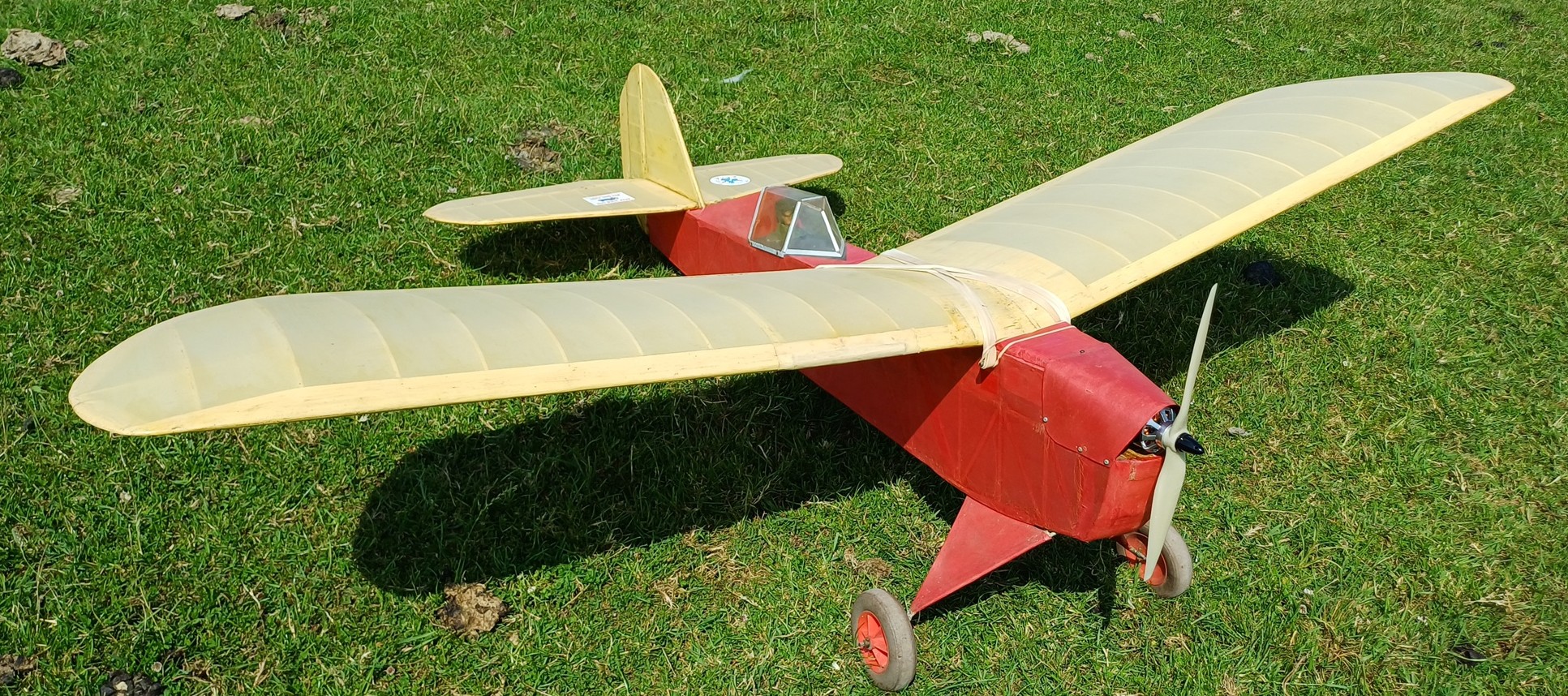 It would still have the wallowy flying characteristic though, so it’s returned to being a hangar queen for now. But at least it flew! Thanks for that Dougal, I rather like it, an ideal model for a calm summer’s day. It’s bound to Dutch roll (wallow) with all that dihedral, not much you can do about that without changing the dihedral but then the Sportster would lose part of it’s charm. I can’t help thinking that six cells provide way too much power, surely it would be fine on four cells, then being lighter and slower maybe there would be less wallowing? Take a look at the video and see for yourselves how it performs.
It would still have the wallowy flying characteristic though, so it’s returned to being a hangar queen for now. But at least it flew! Thanks for that Dougal, I rather like it, an ideal model for a calm summer’s day. It’s bound to Dutch roll (wallow) with all that dihedral, not much you can do about that without changing the dihedral but then the Sportster would lose part of it’s charm. I can’t help thinking that six cells provide way too much power, surely it would be fine on four cells, then being lighter and slower maybe there would be less wallowing? Take a look at the video and see for yourselves how it performs.
The last new model that flew this month was mine, an FMS Futura. I wasn’t looking a for a new model, like many of us I already have too many, but I spotted the Futura on the AliExpress site for just £109.93 with free delivery and it was simply too cheap to resist. 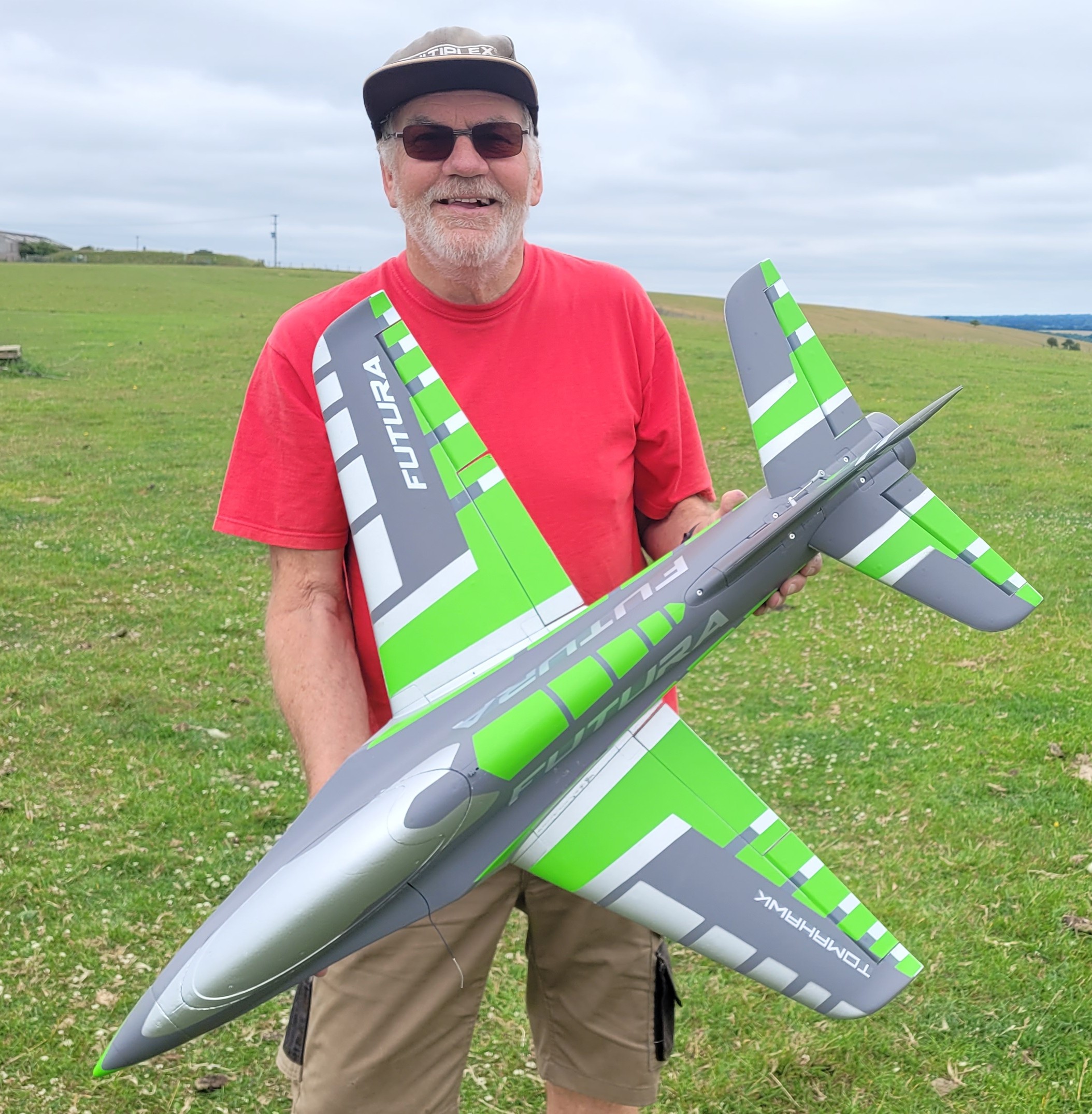 While I was waiting for mine to be delivered the price dropped and on 25th June the price was just £92.15 but the following day it had gone up to £115.46 so keep your eye on it!
While I was waiting for mine to be delivered the price dropped and on 25th June the price was just £92.15 but the following day it had gone up to £115.46 so keep your eye on it!
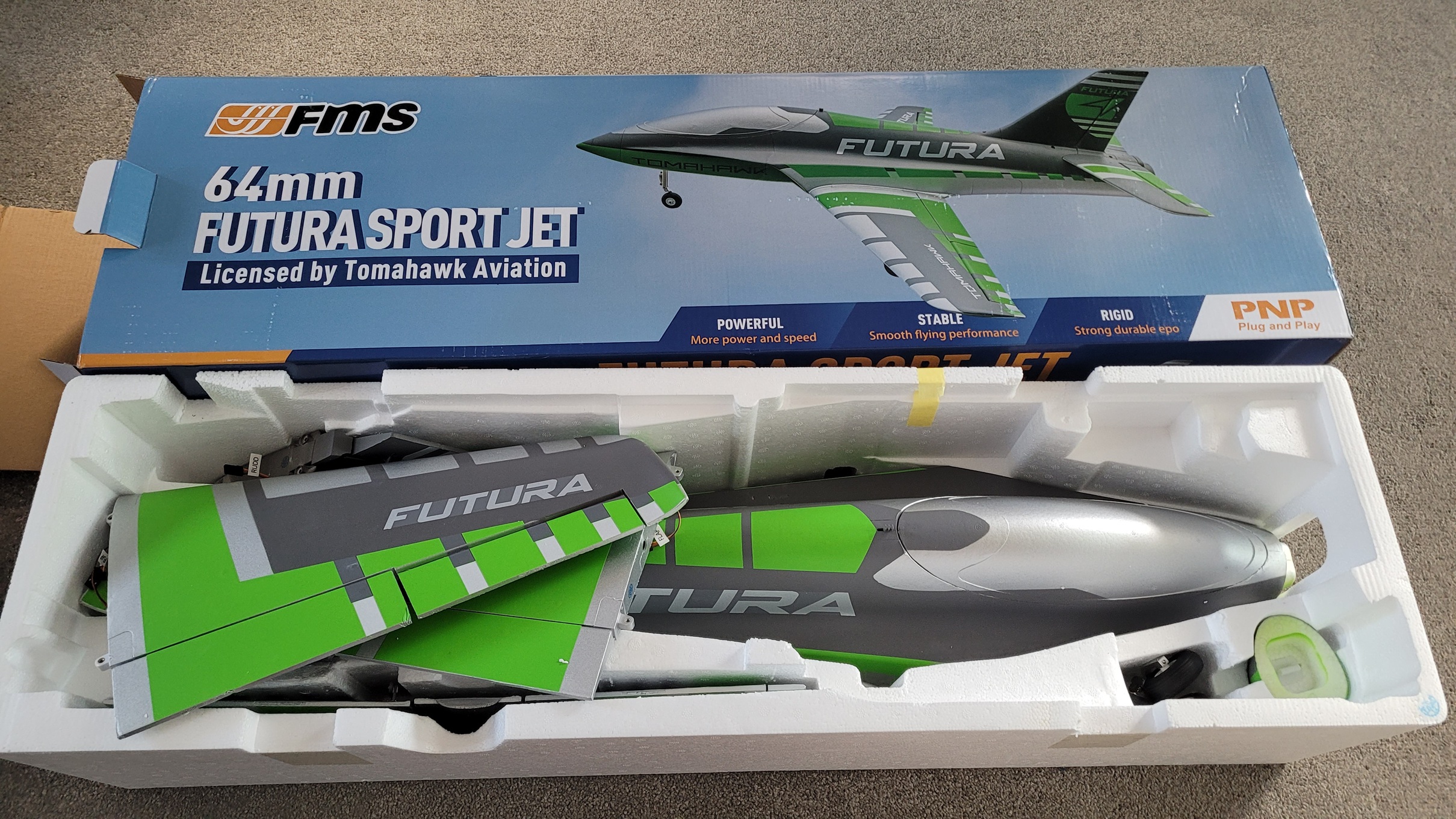 The Futura design has been around for quite a while and there are many versions from enormous turbine powered ones down to small EDF foamies. Mine has a wingspan of 900mm, is fitted with a 64mm fan and runs on four cells. This is what FMS say about it: The FMS Futura is a licensed sport jet developed by FMS in conjunction with Tomahawk-Aviation. Designed by a Sino-German team of engineers, the Futura represents the pinnacle of what a foam jet can be. Futura is definitely a pleasant surprise for those who struggle to choose between speed and stunts. It has high speed, high maneuverability, and excellent handling performance, satisfying players’ needs to experience various flying modes such as free flying, simulation competitions, and stunt flying.
The Futura design has been around for quite a while and there are many versions from enormous turbine powered ones down to small EDF foamies. Mine has a wingspan of 900mm, is fitted with a 64mm fan and runs on four cells. This is what FMS say about it: The FMS Futura is a licensed sport jet developed by FMS in conjunction with Tomahawk-Aviation. Designed by a Sino-German team of engineers, the Futura represents the pinnacle of what a foam jet can be. Futura is definitely a pleasant surprise for those who struggle to choose between speed and stunts. It has high speed, high maneuverability, and excellent handling performance, satisfying players’ needs to experience various flying modes such as free flying, simulation competitions, and stunt flying.
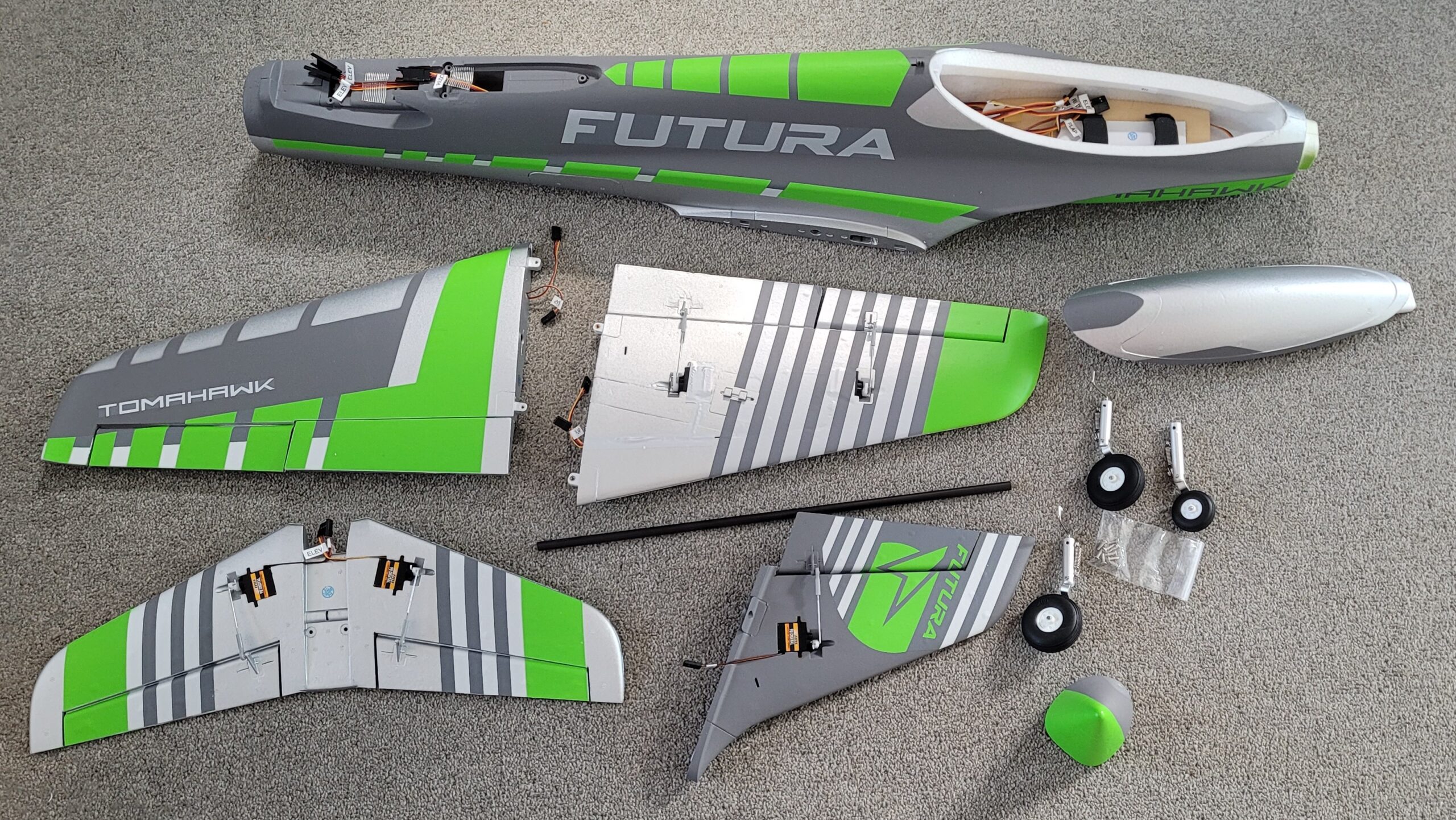 The power system is composed of a high-torque 2840-KV3150 brushless motor, a high-stability 40A ESC, and a 4S 2200mAh-2600mAh battery (to be purchased separately), which is paired with 8pcs high-precision 9g servos mounted on the wings, tail, and front steering position, allowing players to easily experience various control techniques and enjoy the pleasure of high-speed flight. In addition, the wings and tail of Futura have been pre-embedded with reinforced ribbons, and the cockpit is firmly fixed in place with buckle, which allows players to perform aggressive turns, rolls, and flips without any concerns. The CNC all-metal landing gear with trailing-link suspension is highly precise and robust, protecting the plane against rough landings. I placed the order on 26th May and it arrived on 23rd June, a week earlier than the date quoted, and it was in a sturdy box and was undamaged. Construction was simple, the parts simply screw together, no gluing required, then add your own receiver and battery. The ailerons, elevators, flaps, and rudder/steerable noseleg are all fitted with Y leads so only five channels are required.
The power system is composed of a high-torque 2840-KV3150 brushless motor, a high-stability 40A ESC, and a 4S 2200mAh-2600mAh battery (to be purchased separately), which is paired with 8pcs high-precision 9g servos mounted on the wings, tail, and front steering position, allowing players to easily experience various control techniques and enjoy the pleasure of high-speed flight. In addition, the wings and tail of Futura have been pre-embedded with reinforced ribbons, and the cockpit is firmly fixed in place with buckle, which allows players to perform aggressive turns, rolls, and flips without any concerns. The CNC all-metal landing gear with trailing-link suspension is highly precise and robust, protecting the plane against rough landings. I placed the order on 26th May and it arrived on 23rd June, a week earlier than the date quoted, and it was in a sturdy box and was undamaged. Construction was simple, the parts simply screw together, no gluing required, then add your own receiver and battery. The ailerons, elevators, flaps, and rudder/steerable noseleg are all fitted with Y leads so only five channels are required. 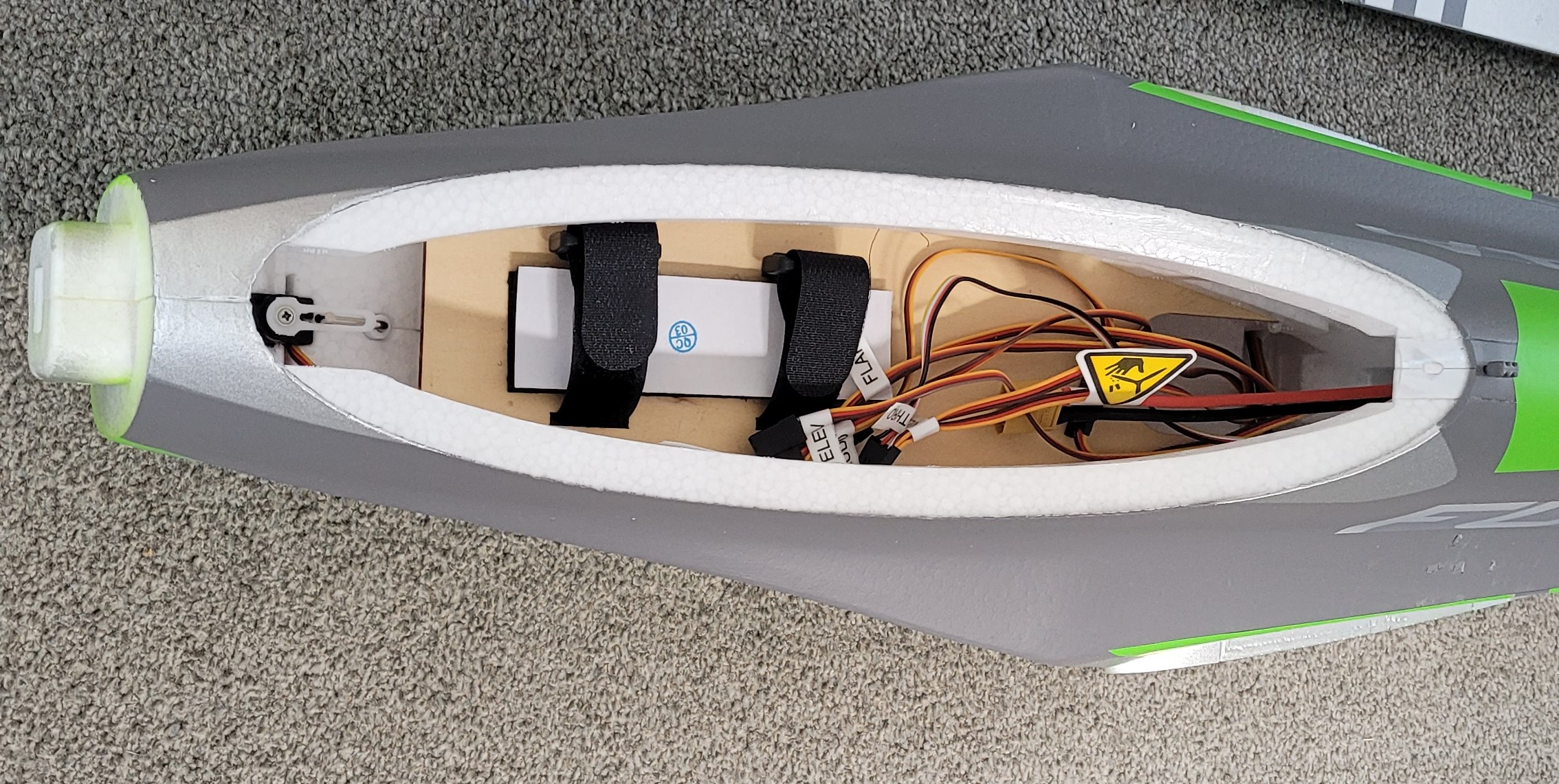 Interestingly the speed controller has an extra signal lead which enables you to have switched reverse thrust but as I am using a five channel receiver I don’t have a spare channel to try it. Presumably you’d only use reverse thrust after landing to slow the model on the ground, or maybe when taxiing, neither of which are relevant on our grass patch. The instructions warn not to engage reverse thrust at more than 50% throttle as it could damage the ESC so it wouldn’t be much use for crazy aerobatic antics!
Interestingly the speed controller has an extra signal lead which enables you to have switched reverse thrust but as I am using a five channel receiver I don’t have a spare channel to try it. Presumably you’d only use reverse thrust after landing to slow the model on the ground, or maybe when taxiing, neither of which are relevant on our grass patch. The instructions warn not to engage reverse thrust at more than 50% throttle as it could damage the ESC so it wouldn’t be much use for crazy aerobatic antics!
 As usual I took some photos of the model before the first flight but then I made the mistake of handing my mobile to Gordon Bennett for him to take a photo of me holding the plane. That’s very childish Gordon (well done!) and his accomplice Woody is no better!
As usual I took some photos of the model before the first flight but then I made the mistake of handing my mobile to Gordon Bennett for him to take a photo of me holding the plane. That’s very childish Gordon (well done!) and his accomplice Woody is no better!
 With the photos taken, the first flight was uneventful, using half flap the Futura took-off from the grass with no problems and then flew beautifully. The power set-up provides plenty of thrust and all the usual manoeuvres are possible. I landed using half flap and the Futura came in nicely and landed gently, no doubt helped by the sprung oleo legs.
With the photos taken, the first flight was uneventful, using half flap the Futura took-off from the grass with no problems and then flew beautifully. The power set-up provides plenty of thrust and all the usual manoeuvres are possible. I landed using half flap and the Futura came in nicely and landed gently, no doubt helped by the sprung oleo legs.
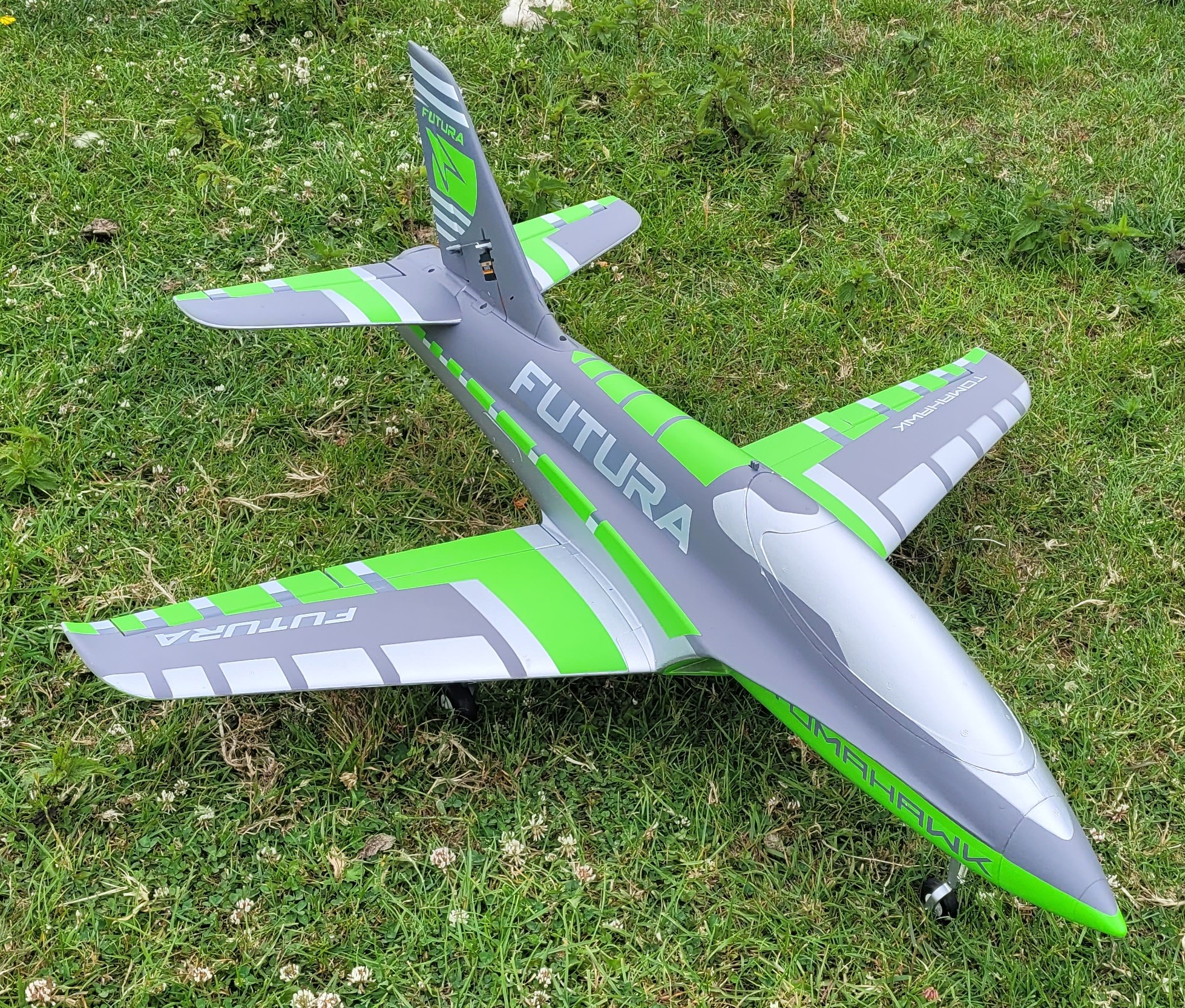 At the time of writing I’ve had three flights with no problems and I’m gradually getting used it’s characteristics. You can of course see some of the flying in this month’s video.
At the time of writing I’ve had three flights with no problems and I’m gradually getting used it’s characteristics. You can of course see some of the flying in this month’s video.
This month the ‘action shots’ aren’t action shots at all (my blog, my rules!):
I’m not sure if I’ve ever mentioned it (!) but back in October 2020 I was fortunate enough to have a flight in a two seat Spitfire from Solent Airport Daedalus, courtesy of my son. 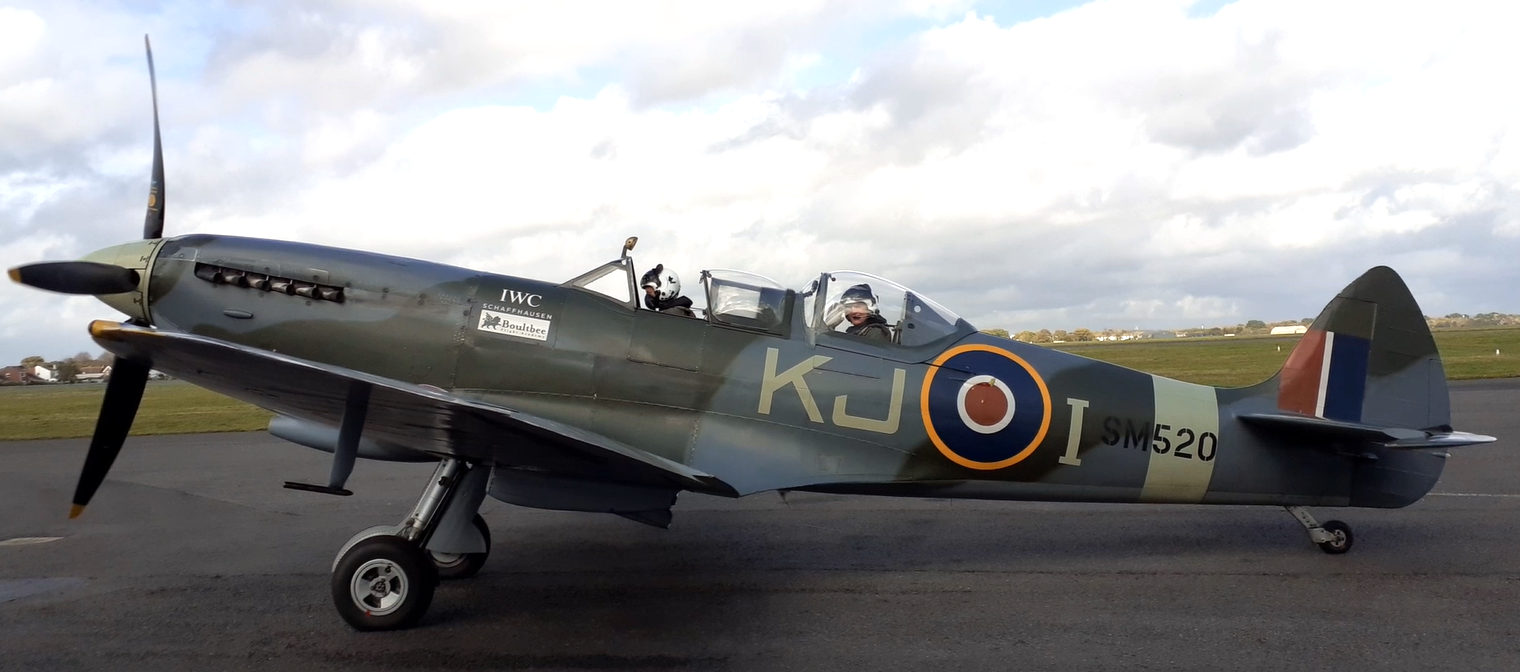
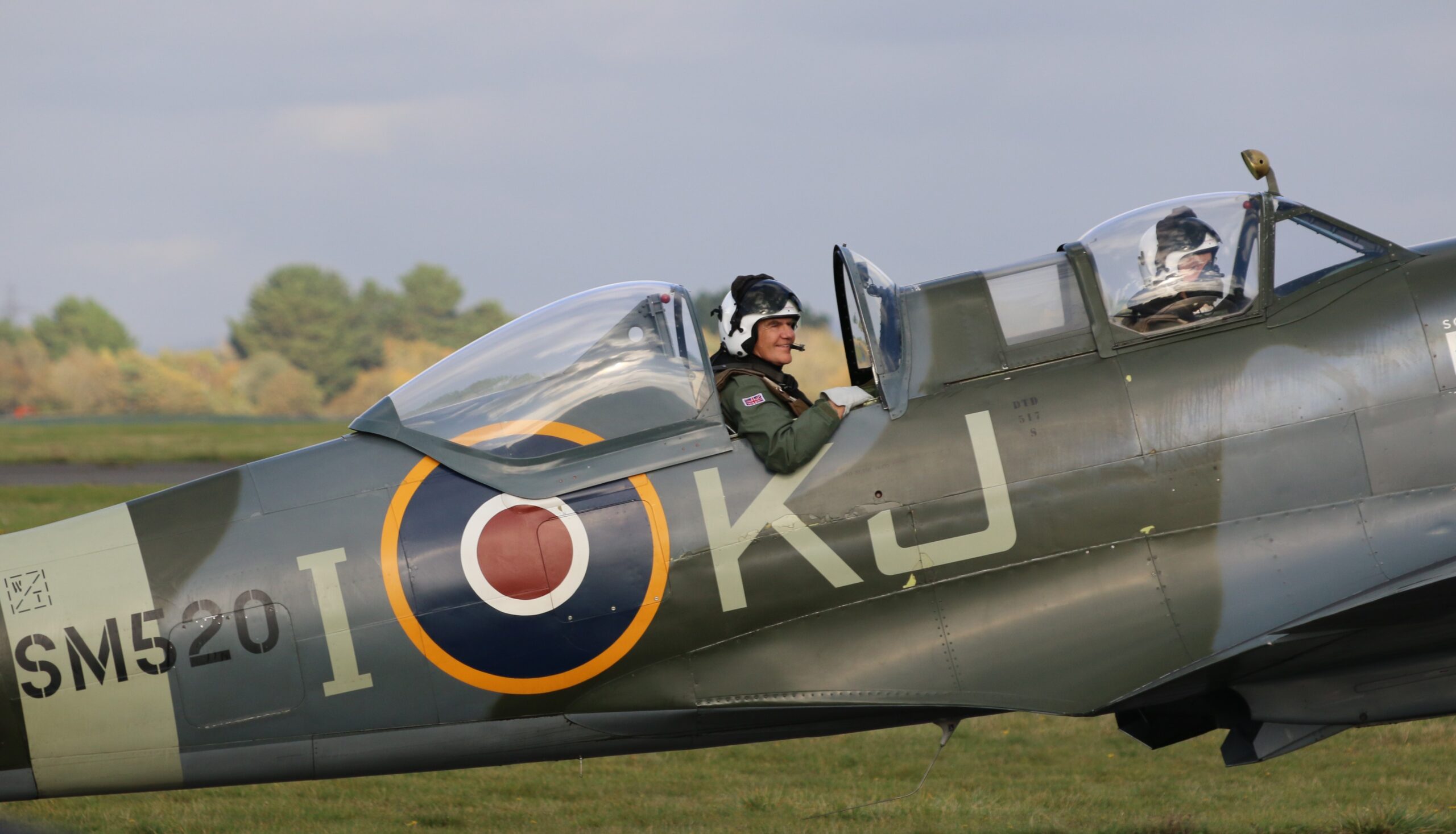
For some strange reason some club members seem to think I mention it far too much, and at the end of June Woody bought me a present in the hope that it’ll finally shut me up!

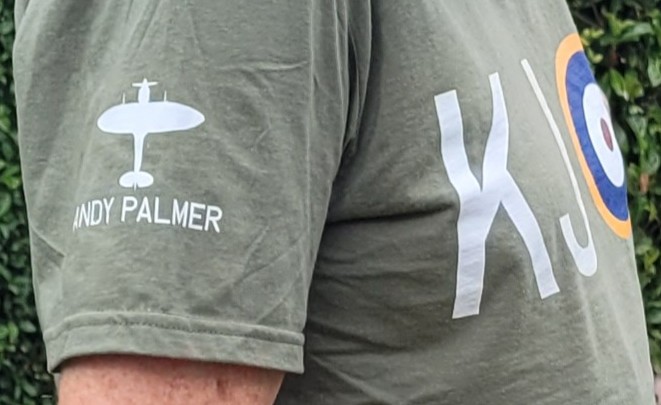
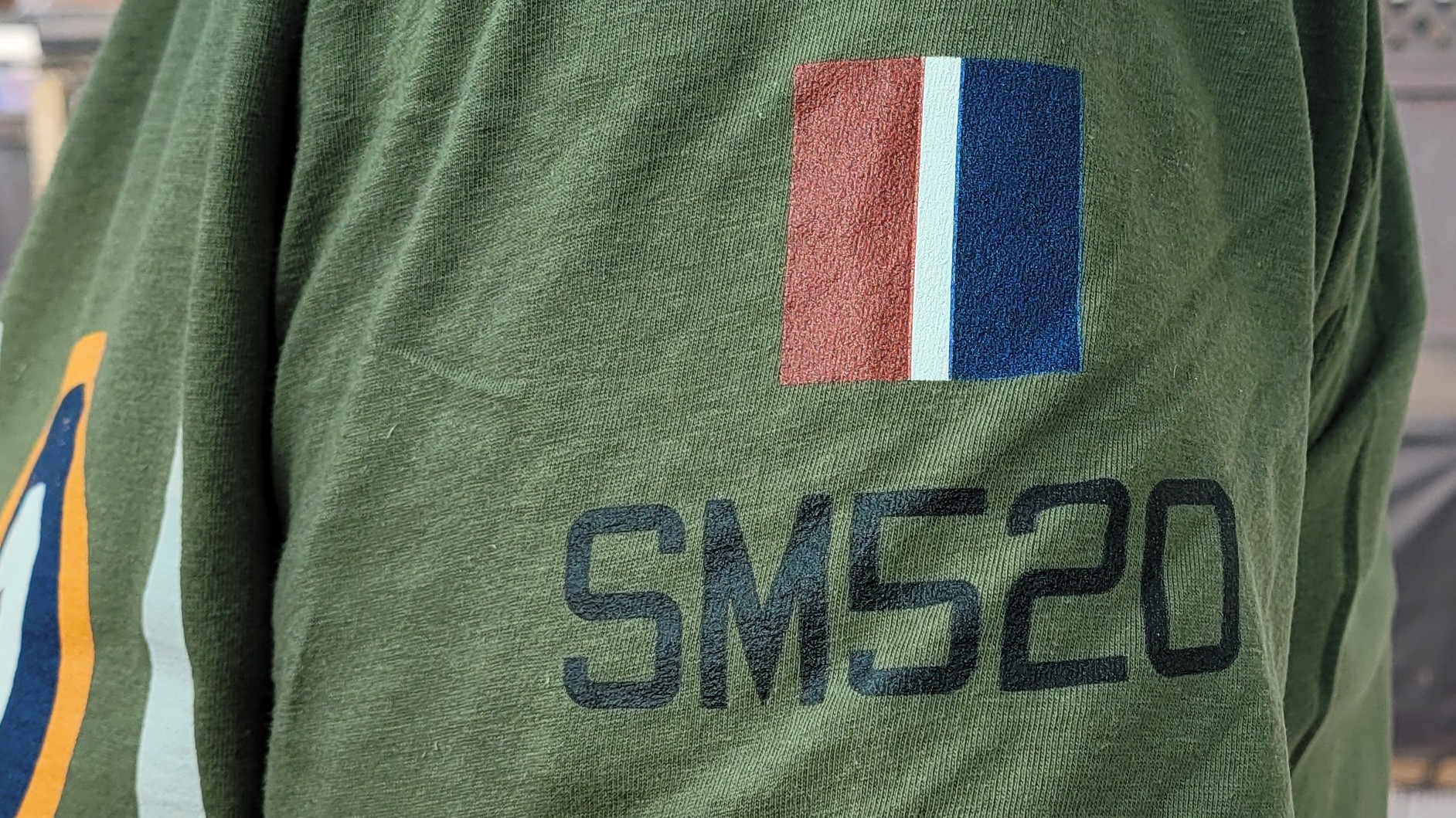 A T-shirt with all the correct aircraft markings! Thanks Woody… but it won’t shut me up!
A T-shirt with all the correct aircraft markings! Thanks Woody… but it won’t shut me up!
Video time now, this month with footage shot by me, MacFly, Dougal, and Dot Cottam.
Please watch the video full-screen, it’s so much better with small models flying around:
If the video won’t play for you please click HERE
Final Funny:
No joke this month but I saw this and it made me chuckle

Colin Cowplain


Thank you Colin. Missed the joke at the end though.